All posts by Andrea Grant
About Andrea Grant
Andrea Grant is a Children's Services Specialist. View all posts by Andrea Grant →
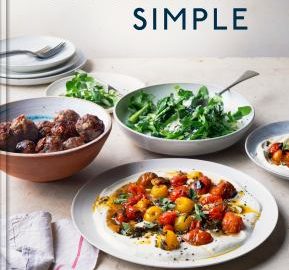
Bibliobites in April: Plenty Simple?
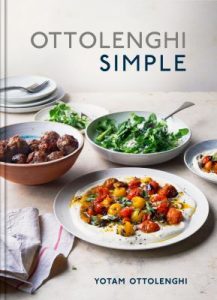 In the kitchen, we’re often looking to simplify– to create maximum joy on the plate with minimum time and effort. Of course we want to eat something interesting and flavorful, but we don’t want to spend hours getting there. And we also might want something new and different, too! April’s title, Ottolenghi Simple by superstar chef/author Yotam Ottolenghi, seemed tailor-made for our list of dinnertime desires: “supremely streamlined” recipes with signature Middle Eastern herbs and spices that aim to create “drama in the mouth.” While Ottolenghi may be widely known and rightly praised for his traditional yet inventive Mediterranean cuisine, he’s also notorious for recipes with long lists of seasonings and much chopping of ingredients; so could his food be simplified without losing its heart and soul?
In the kitchen, we’re often looking to simplify– to create maximum joy on the plate with minimum time and effort. Of course we want to eat something interesting and flavorful, but we don’t want to spend hours getting there. And we also might want something new and different, too! April’s title, Ottolenghi Simple by superstar chef/author Yotam Ottolenghi, seemed tailor-made for our list of dinnertime desires: “supremely streamlined” recipes with signature Middle Eastern herbs and spices that aim to create “drama in the mouth.” While Ottolenghi may be widely known and rightly praised for his traditional yet inventive Mediterranean cuisine, he’s also notorious for recipes with long lists of seasonings and much chopping of ingredients; so could his food be simplified without losing its heart and soul?
Most in the group thought the recipes were “sort of” simple; they had some simple attributes, but overall we found this book a bit fussy– partly because the cuisine is less familiar to us, but also because prep could be time-consuming and convoluted. To help readers, in this book the word “simple” is an acronym for short on time; ten or fewer ingredients; make ahead; pantry-led; lazy-day; and easier than you think. Recipes are marked with color-coded letters to alert us to the ways in which it was simple– a feature none of us wound up using. For some reason, it was difficult to remember what the letters stood for, and sometimes we just didn’t notice them (even though they’re at the top of every page!). As always, we chose recipes based on what called to us and what we might have on hand.
Ottolenghi’s cooking is generally vegetable-centric, which most of us enjoy. Starting with salads, tomatoes with sumac shallots and pine nuts was “good– and it was pretty simple,” as was chopped salad with tahini and za’atar. Both of these would likely be better with August tomatoes, though they were still tasty and added welcome crunch to a meal. Curried egg and cauliflower salad, a riff on the classic British coronation chicken, was “not bad,” part of the problem being that it made a lot and leftovers couldn’t be frozen. It would be a nice side dish for a group. 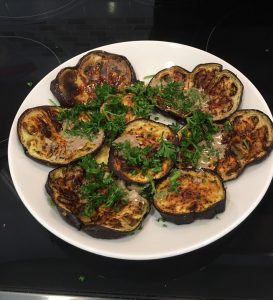 Roasted eggplant with anchovies and oregano was loaded with umami; in addition to being a “very good” side dish, “it would be even better as a spread on bruschetta or pizza.” Asparagus also got into the oven with roasted asparagus with almonds, capers, and dill, which was a “very easy, very tasty” combination– a keeper! On the other hand, roasted cabbage with tarragon and pecorino was visually unappealing and had just “OK” flavor, despite its assertive ingredient list. Two people tried mustardy cauliflower cheese, a comforting gooey gratin of cauliflower with ample cheesy sauce. We thought it could have used more mustard but less cumin, which became a bit too strong after a few days in the fridge. Butternut squash with corn salsa, feta, and pumpkin seeds was a good combination, but the timing of the recipe was a bit off– the squash was too mushy when cooked as directed. And brussels sprouts with browned butter and black garlic were “fussy” and just “OK.”
Roasted eggplant with anchovies and oregano was loaded with umami; in addition to being a “very good” side dish, “it would be even better as a spread on bruschetta or pizza.” Asparagus also got into the oven with roasted asparagus with almonds, capers, and dill, which was a “very easy, very tasty” combination– a keeper! On the other hand, roasted cabbage with tarragon and pecorino was visually unappealing and had just “OK” flavor, despite its assertive ingredient list. Two people tried mustardy cauliflower cheese, a comforting gooey gratin of cauliflower with ample cheesy sauce. We thought it could have used more mustard but less cumin, which became a bit too strong after a few days in the fridge. Butternut squash with corn salsa, feta, and pumpkin seeds was a good combination, but the timing of the recipe was a bit off– the squash was too mushy when cooked as directed. And brussels sprouts with browned butter and black garlic were “fussy” and just “OK.”
There was plenty to choose from in the main dish category, for both carnivores and vegetarians. Middle Eastern cuisine often features a lot of lamb, and this book is no exception. That was problematic for some; a number of people don’t like lamb. But maybe it’s time to try it again, since some of the recipes using it were quite tasty. For instance, lamb and pistachio patties with sumac yogurt sauce were “easy” and had “really good flavor.” The sumac sauce was an excellent lemony foil for the patties; and the sauce turned out to be delicious over roasted vegetables as well. Two people made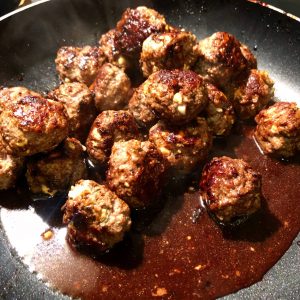 lamb and feta meatballs, which was also a yummy combination, and the optional pomegranate molasses glaze was the perfect accent. However the recipe needed more of a binder than the breadcrumbs called for; the meatballs tended to fall apart. An egg helped! And the directions called for frying and then baking the meatballs, when just baking would have been easier, less messy, and equally good. But overall, definitely worth making again. Slow-cooked lamb shoulder with mint and cumin turned out just “OK;” the included veggies (celery root and carrot) didn’t seem to add much to the overall flavor, and a bigger problem was that the instructions called for cooking at 350 degrees for 6 hours. That time span almost certainly calls for a lower temp if you didn’t want to turn your expensive lamb into a tough mess. Oddly we didn’t make much chicken or fish; we did try seeded chicken schnitzel, which was kind of a high-class version of chicken fingers. The seed-ful coating was crunchy and flavorful, but unfortunately this dish didn’t age that well– the flavors faded and it’s hard to reheat boneless chicken breast without drying it out.
lamb and feta meatballs, which was also a yummy combination, and the optional pomegranate molasses glaze was the perfect accent. However the recipe needed more of a binder than the breadcrumbs called for; the meatballs tended to fall apart. An egg helped! And the directions called for frying and then baking the meatballs, when just baking would have been easier, less messy, and equally good. But overall, definitely worth making again. Slow-cooked lamb shoulder with mint and cumin turned out just “OK;” the included veggies (celery root and carrot) didn’t seem to add much to the overall flavor, and a bigger problem was that the instructions called for cooking at 350 degrees for 6 hours. That time span almost certainly calls for a lower temp if you didn’t want to turn your expensive lamb into a tough mess. Oddly we didn’t make much chicken or fish; we did try seeded chicken schnitzel, which was kind of a high-class version of chicken fingers. The seed-ful coating was crunchy and flavorful, but unfortunately this dish didn’t age that well– the flavors faded and it’s hard to reheat boneless chicken breast without drying it out. 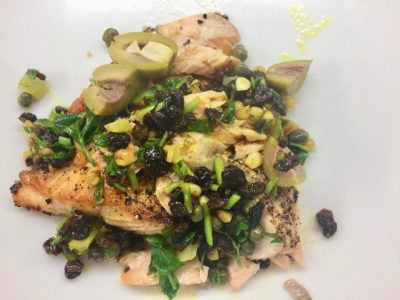 Bridget Jones’s pan-fried salmon with pine nut salsa had a “cute headnote” and the fish was pretty good, too! The salsa in particular was a keeper. Roasted trout with tomato, orange, and barberry salsa also boasted a winning topper, “very much liked!”
Bridget Jones’s pan-fried salmon with pine nut salsa had a “cute headnote” and the fish was pretty good, too! The salsa in particular was a keeper. Roasted trout with tomato, orange, and barberry salsa also boasted a winning topper, “very much liked!”
We worked our way through several vegetarian mains, as well. 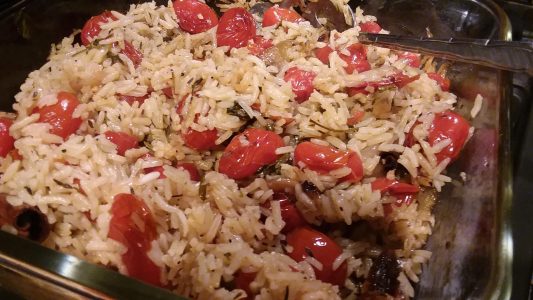 Baked rice with confit tomatoes and garlic could be a side or a main; the tomatoes and spices elevated the rice to something savory and special. On the other hand, couscous, cherry tomato, and herb salad turned out just “OK;” the dressing was kind of “blah.” But the mint in the salad was a perfect addition! Puy lentil and eggplant stew was “better than I thought it would be” though it didn’t get points in the looks department, “browny and mushy!” Despite that, “I’ll make again.” Two people tried gigli with chickpeas and za’atar, which could have used more sauce, but “we really liked it.” Though this recipe wasn’t difficult, it didn’t seem super-simple with its “many steps.” Also featuring pasta, pappardelle with rose harissa, black olives, and capers had good flavors, with plenty of salty umami from the olives and capers. Rose harissa proved difficult to find so our cook made her own (non-rose) harissa, which worked well. Anchovy and samphire spaghetti highlighted an unfamiliar and unlocatable sea vegetable; the author suggests using asparagus as a substitute, and the resulting dish came together very quickly and was delicious with its notes of lemon and garlic. And curried lentil, tomato, and coconut soup was a winner– both people who made it thought it was a keeper. This dish features quick-cooking red lentils accented with tomatoes, cilantro, and coconut milk. It made a great leftover, only improving in the fridge, and it’s vegan to boot.
Baked rice with confit tomatoes and garlic could be a side or a main; the tomatoes and spices elevated the rice to something savory and special. On the other hand, couscous, cherry tomato, and herb salad turned out just “OK;” the dressing was kind of “blah.” But the mint in the salad was a perfect addition! Puy lentil and eggplant stew was “better than I thought it would be” though it didn’t get points in the looks department, “browny and mushy!” Despite that, “I’ll make again.” Two people tried gigli with chickpeas and za’atar, which could have used more sauce, but “we really liked it.” Though this recipe wasn’t difficult, it didn’t seem super-simple with its “many steps.” Also featuring pasta, pappardelle with rose harissa, black olives, and capers had good flavors, with plenty of salty umami from the olives and capers. Rose harissa proved difficult to find so our cook made her own (non-rose) harissa, which worked well. Anchovy and samphire spaghetti highlighted an unfamiliar and unlocatable sea vegetable; the author suggests using asparagus as a substitute, and the resulting dish came together very quickly and was delicious with its notes of lemon and garlic. And curried lentil, tomato, and coconut soup was a winner– both people who made it thought it was a keeper. This dish features quick-cooking red lentils accented with tomatoes, cilantro, and coconut milk. It made a great leftover, only improving in the fridge, and it’s vegan to boot.
After all the cooking was done, there were lots of opinions about the experience. On the plus side, group members used some new-to-them spices that they fell in love with, particularly sumac and Aleppo pepper. We enjoyed many of the flavors that have come to define Ottolenghi– familiar friends like lemon, garlic, and anchovy; and new ones like sumac, za’atar, and pomegranate molasses. We liked the book itself, with its typical large format; and there was uniform praise for the photography and layout. On the downside, the large quantities of fresh herbs needed was a bit problematic for April in New England, both expensive and/or difficult to come by. And there seemed to be a fair amount of prep for a “simple” book. Also, some just aren’t crazy about Middle Eastern flavors in general, though others wished the book had more focus on what Ottolenghi is justly known for. In trying to simplify, we thought the food lost some of its distinctive qualities– so maybe it’s Middle Eastern lite? Several years ago (in February 2015!) our group reviewed Ottolenghi’s best-seller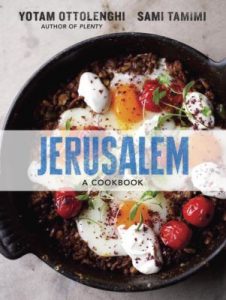 Jerusalem, which, as the title indicates, is more sharply focused on those particular ingredients and flavors. Despite its being more complicated to cook from, we preferred that book. Go figure! In the end, even though some of us found some keepers, no one was that enthusiastic about this title, and our voting averaged out to 2.25 (out of a possible 5). We’re a tough crowd, and apparently we’ve gotten harder to impress as the months go by!
Jerusalem, which, as the title indicates, is more sharply focused on those particular ingredients and flavors. Despite its being more complicated to cook from, we preferred that book. Go figure! In the end, even though some of us found some keepers, no one was that enthusiastic about this title, and our voting averaged out to 2.25 (out of a possible 5). We’re a tough crowd, and apparently we’ve gotten harder to impress as the months go by!
We’ll next meet on Friday, May 28 at 11 AM, where we’ll be discussing Mark Bittman’s boldly titled Dinner For Everyone. Copies are available at the main circulation desk, or via curbside pickup. Plan to chat via Zoom; if you’re not already on our mailing list and would like to attend, please email group leader Andrea Grant. See you then!
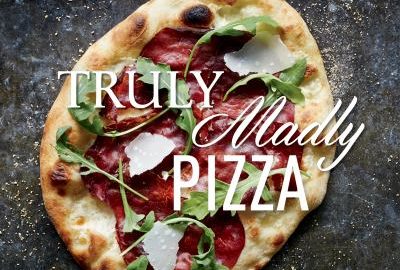
Bibliobites in March: Pizza: A Love Story
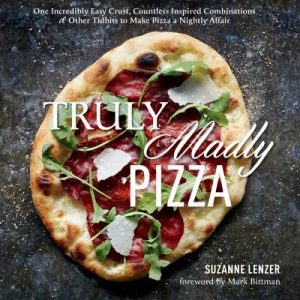 America’s love affair with pizza is deep and enduring (dare we say passionate?), and continues to blossom in new and unexpected ways. In fact, one could argue that pizza is a unifying cultural force, because who doesn’t love pizza? Regardless of age, race, gender, ethnicity, or political persuasion, there are very few of us who have never happily downed a slice of cheesy goodness. According to multiple sources, over 90% of Americans consume pizza at least once a month, and the ongoing pandemic has probably only increased that number! Though most of us are quite content to get our pizza fix through takeout or delivery, our ever-intrepid Bibliobites group spent the month of March perfecting homemade pies. The pros have 900-degree ovens and plenty of experience with finicky pizza dough– could we even come close to that? And ultimately, would we even want to bother, when ordering from any number of places is oh so quick and easy?
America’s love affair with pizza is deep and enduring (dare we say passionate?), and continues to blossom in new and unexpected ways. In fact, one could argue that pizza is a unifying cultural force, because who doesn’t love pizza? Regardless of age, race, gender, ethnicity, or political persuasion, there are very few of us who have never happily downed a slice of cheesy goodness. According to multiple sources, over 90% of Americans consume pizza at least once a month, and the ongoing pandemic has probably only increased that number! Though most of us are quite content to get our pizza fix through takeout or delivery, our ever-intrepid Bibliobites group spent the month of March perfecting homemade pies. The pros have 900-degree ovens and plenty of experience with finicky pizza dough– could we even come close to that? And ultimately, would we even want to bother, when ordering from any number of places is oh so quick and easy?
 We had two titles to guide us on our path to pizza perfection: Truly Madly Pizza by Suzanne Lenzer, and Todd English’s Rustic Pizza by Todd English. Both feature extensive information and instruction on crust-making, arguably the most intimidating part of producing pizza at home. Some found the multiple pages of instructions to be a bit of overkill, but once we got past the plethora of details, the dough was simple enough to make. Two people had high praise for Lenzer’s dough, which made a light, slightly chewy thin crust. This dough required a fermentation period, so you needed to make it ahead (at least 8 hours); but this did make evening pizza production quicker. English’s crust didn’t insist on a waiting time, which worked well if you were using regular white flour; but if you sourced the suggested “00” Italian-style flour, the crust was much tastier after sitting in the fridge for a day. Though making your own crust is quick and easy (once you’ve digested all those instructions!), many in the group don’t bother with making their own pizza crust, especially since there are now plenty of respectable alternatives out there. Many supermarkets carry more than one brand of dough, and some takeout places sell theirs (one member likes the dough from Sal’s). Plus there are always premade crusts (like Boboli); and lavash, pita, or naan are also good bases if you’re in a hurry.
We had two titles to guide us on our path to pizza perfection: Truly Madly Pizza by Suzanne Lenzer, and Todd English’s Rustic Pizza by Todd English. Both feature extensive information and instruction on crust-making, arguably the most intimidating part of producing pizza at home. Some found the multiple pages of instructions to be a bit of overkill, but once we got past the plethora of details, the dough was simple enough to make. Two people had high praise for Lenzer’s dough, which made a light, slightly chewy thin crust. This dough required a fermentation period, so you needed to make it ahead (at least 8 hours); but this did make evening pizza production quicker. English’s crust didn’t insist on a waiting time, which worked well if you were using regular white flour; but if you sourced the suggested “00” Italian-style flour, the crust was much tastier after sitting in the fridge for a day. Though making your own crust is quick and easy (once you’ve digested all those instructions!), many in the group don’t bother with making their own pizza crust, especially since there are now plenty of respectable alternatives out there. Many supermarkets carry more than one brand of dough, and some takeout places sell theirs (one member likes the dough from Sal’s). Plus there are always premade crusts (like Boboli); and lavash, pita, or naan are also good bases if you’re in a hurry.
 OK– crust conquered! On to the toppings! Interestingly, though both books have sauce recipes, many of the pizza recipes feature no sauce. The sauces in both books were solid, though “nothing to write home about.” One person did think that English’s sauce was “really good;” but neither sauce stood out enough to be a keeper. Beyond red sauce, there were plenty of toppings to try, both traditional and more unusual. Two people made roast chicken with fennel and onion jam, which was a tasty combination, though it “needed something.” One person added a drizzle of balsamic vinegar, which seemed to do the trick. But the recipe was good enough that it was worth another try. A few recipes used caramelized onion jam, which was “delicious– I liked it a lot,” and was a good condiment to have on hand. Marinated artichokes with spinach and feta was a yummy version of this classic combination; and
OK– crust conquered! On to the toppings! Interestingly, though both books have sauce recipes, many of the pizza recipes feature no sauce. The sauces in both books were solid, though “nothing to write home about.” One person did think that English’s sauce was “really good;” but neither sauce stood out enough to be a keeper. Beyond red sauce, there were plenty of toppings to try, both traditional and more unusual. Two people made roast chicken with fennel and onion jam, which was a tasty combination, though it “needed something.” One person added a drizzle of balsamic vinegar, which seemed to do the trick. But the recipe was good enough that it was worth another try. A few recipes used caramelized onion jam, which was “delicious– I liked it a lot,” and was a good condiment to have on hand. Marinated artichokes with spinach and feta was a yummy version of this classic combination; and  sweet and sour onions with butternut squash and ricotta was also a winner with its caramelized squash and pillowy ricotta. But, caramelized fennel and pears with stilton was way too heavy on the blue cheese; perhaps a milder blue would have played more nicely with the other ingredients? If you can’t or don’t do dairy, there were several no-cheese options; curried cauliflower with tomatoes and cilantro
sweet and sour onions with butternut squash and ricotta was also a winner with its caramelized squash and pillowy ricotta. But, caramelized fennel and pears with stilton was way too heavy on the blue cheese; perhaps a milder blue would have played more nicely with the other ingredients? If you can’t or don’t do dairy, there were several no-cheese options; curried cauliflower with tomatoes and cilantro had so many lively flavors that you didn’t even notice that there was no cheese involved. Broccolini, mushroom, and crunchy breadcrumbs, though it contained a small amount of ricotta, would have been equally good without it– or maybe with some of that marinara sauce?
had so many lively flavors that you didn’t even notice that there was no cheese involved. Broccolini, mushroom, and crunchy breadcrumbs, though it contained a small amount of ricotta, would have been equally good without it– or maybe with some of that marinara sauce?
All of the above recipes are from Truly Madly Pizza.
While most of us had checked out Lenzer’s book, a few dipped into Todd English’s. One person praised his almond pesto, which was creamy and delicious and almost dairy-free, having only one teaspoon of Parmesan in the batch. Chicken chili was used as a topping, though of course it could be eaten on its own; this was “worth trying” especially if you’re a beer lover, since that was its signature ingredient. The margherita was a solid version of this classic, and the roasted eggplant pizza was “really good,” with plenty of eggplant complemented by the traditional sauce and cheese. Chicken tikka masala pizza was a keeper; it used jarred tikka sauce for an easy flavor boost, and you could use naan for the crust, as suggested.
There were, as always, some complaints. Many, if not most, of Ms. Lenzer’s pizza toppings consisted of ingredients scattered over the crust; often there wasn’t a binding ingredient like sauce, and/or the cheese was dolloped rather than spread all over. The toppings would often fall off as we tried to cut and/or eat the pizza, which was a bit frustrating and sometimes messy. And even though many topping combinations were delicious, they were things we probably could have just pulled out of our own fridge; there wasn’t much that was really innovative (or maybe we’ve just been spoiled by the numerous choices we’ve already sampled via takeout?). Still, most of the pizzas were tasty and quick to put together once we had the dough made or bought; and both authors’ recipes certainly took us beyond your standard cheese and pepperoni, should you want to branch out.
So after the ovens had cooled, did either of these books turn us into at-home pizzaiolos? We started our meeting with most saying they rarely or never make pizza at home– and at the end of our discussion opinions hadn’t changed much. Takeout pizza is widely available, and in our area we’re lucky to have several high-quality options. On the other hand, some in the group say they only eat homemade pizza; but they already have their favorite ways of doing things, and neither book motivated them to change. But a few (including yours truly) were inspired by Ms. Lenzer’s dough to make more pizza at home, now that they’ve become familiar with her reliable and simple recipe. Voting reflected our overall ambivalence, with both books averaging out to just over 3 (out of a possible 5). Our love for pizza may indeed know no bounds– but most of the time, we’ll let the pros do the cooking!
Survey says….We started our meeting with a brief poll:
If you want to eat pizza in a restaurant, where would you go?
- Bertucci’s (Chelmsford), “still good!”
- Evvivva Trattoria (Westford), “like the high-tops, good beer selection!”
- Cane Rosso (Dallas TX), a bit of a hike, but “absolutely delicious– lots of different toppings!”
- Pizzario (Hillsboro, OR), an even bigger hike, “olive oil in/on the crust is very delicious– love the live music and local art on the walls.”
- Longtime New England favorites Pizzeria Regina and Frank Pepe’s.
- Newer local chains Otto’s and Max and Leo’s
For takeout only, where would you go (if different from above)?
- Silver Palate (Westford), “I like that they also will make pizza on Syrian bread.”
- Sal’s (Chelmsford and others), “they sell giant slices!”
- Chelmsford Pizza (Chelmsford), “Greek-style pizza…fantastic gargantuan roast beef sandwich.”
Favorite pizza topping:
- Mushroom (3 people)
- Onion
- Sausage
- Prosciutto
- Roasted red pepper
- Pepperoni
- Anchovy
If you’re ready to move on from pizza, join us at our next meeting on Friday, April 30 at 11 AM; we’ll be discussing Ottolenghi Simple, a streamlined take on Middle Eastern-ish food by well-known chef/restaurateur Yotam Ottolenghi. Copies are available at the main circulation desk or via curbside pickup. We’ll chat on the 30th via Zoom; if you would like to attend but are not already on our Bibliobites mailing list, please email group leader Andrea Grant. See you then!
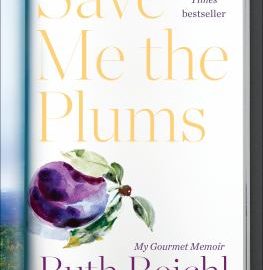
Bibliobites in February: Those Were the Days, My Friends
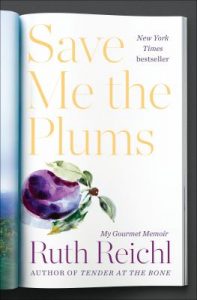 Author/editor/critic Ruth Reichl has had a long and storied career in the food world; and she’s shared many of her unique experiences in a series of memoirs. Our Bibliobites group first perused this territory back in 2014, when we reviewed Garlic and Sapphires, Ms. Reichl’s engaging and revealing memoir of her years as a restaurant critic for the NY Times. This month’s title, Save Me the Plums, covers 10 years post-Times when the author was editor-in-chief of the late, lamented Gourmet magazine. The good, the bad, the ugly, and the incredibly expensive are all chronicled in the author’s eminently readable style; and we all learned maybe more than we ever wanted to know about magazine publishing!
Author/editor/critic Ruth Reichl has had a long and storied career in the food world; and she’s shared many of her unique experiences in a series of memoirs. Our Bibliobites group first perused this territory back in 2014, when we reviewed Garlic and Sapphires, Ms. Reichl’s engaging and revealing memoir of her years as a restaurant critic for the NY Times. This month’s title, Save Me the Plums, covers 10 years post-Times when the author was editor-in-chief of the late, lamented Gourmet magazine. The good, the bad, the ugly, and the incredibly expensive are all chronicled in the author’s eminently readable style; and we all learned maybe more than we ever wanted to know about magazine publishing!
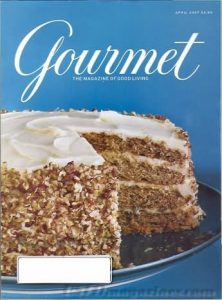 Speaking of Gourmet, thanks to the internet we were able to obtain back issues of the magazine from 2007 and 2009– 2007 perhaps being close to its heyday, and 2009 representing its final year. Having the actual product in our hands, after reading about all the time and effort that went into creating it, really brought those chapters of the memoir to life. But, it must be said that the magazine left most of us cold. We thought too many of the recipes were overly time-consuming (a criticism that was often leveled at the magazine), and elaborate in an unnecessary way. For example, one issue had a recipe for fettuccine lasagna with meatballs that was a three-day affair; and it didn’t seem that much different than your average one-day lasagna. It may have been worth it, but the full page of instructions was a bit intimidating. We were also incredibly distracted by the pages and pages of ads (“so many!”) for super-expensive items, often featuring “rich people on vacation.” This overt conspicuous consumption was a big turn-off for us. The world Ms. Reichl inhabited at Gourmet seemed so unreal to us; it was like something you’d read in a book (!), and the magazine faithfully reflected that world. It turned out that most in our group had been Bon Appetit readers, and we didn’t know until we read this memoir that it was considered the plain-Jane poor relation of Gourmet. There’s aspirational, and then there’s completely out of our league– which is how the Gourmet issues felt.
Speaking of Gourmet, thanks to the internet we were able to obtain back issues of the magazine from 2007 and 2009– 2007 perhaps being close to its heyday, and 2009 representing its final year. Having the actual product in our hands, after reading about all the time and effort that went into creating it, really brought those chapters of the memoir to life. But, it must be said that the magazine left most of us cold. We thought too many of the recipes were overly time-consuming (a criticism that was often leveled at the magazine), and elaborate in an unnecessary way. For example, one issue had a recipe for fettuccine lasagna with meatballs that was a three-day affair; and it didn’t seem that much different than your average one-day lasagna. It may have been worth it, but the full page of instructions was a bit intimidating. We were also incredibly distracted by the pages and pages of ads (“so many!”) for super-expensive items, often featuring “rich people on vacation.” This overt conspicuous consumption was a big turn-off for us. The world Ms. Reichl inhabited at Gourmet seemed so unreal to us; it was like something you’d read in a book (!), and the magazine faithfully reflected that world. It turned out that most in our group had been Bon Appetit readers, and we didn’t know until we read this memoir that it was considered the plain-Jane poor relation of Gourmet. There’s aspirational, and then there’s completely out of our league– which is how the Gourmet issues felt.
 On the plus side, we did love the photography in the magazines; and though some of the covers didn’t appeal to us (“that wouldn’t stop me dead in my tracks at the newsstand”), we could appreciate their unique qualities. During Ms. Reichl’s tenure, much effort was expended to improve both the visuals and the quality of the articles, and we felt that overall the effort was successful. A few people mentioned that they weren’t really drawn into the writing in their issue; as is often the case, some articles were better than others. We all loved David Foster Wallace’s article, “Consider the Lobster” which generated much controversy when it was first published in 2004, but which would likely be considered mainstream today.
On the plus side, we did love the photography in the magazines; and though some of the covers didn’t appeal to us (“that wouldn’t stop me dead in my tracks at the newsstand”), we could appreciate their unique qualities. During Ms. Reichl’s tenure, much effort was expended to improve both the visuals and the quality of the articles, and we felt that overall the effort was successful. A few people mentioned that they weren’t really drawn into the writing in their issue; as is often the case, some articles were better than others. We all loved David Foster Wallace’s article, “Consider the Lobster” which generated much controversy when it was first published in 2004, but which would likely be considered mainstream today.  Staying with lobster for the moment, thanks to the internet (again!) we were able to read 1946’s “Night of Lobster” by Robert P. T. Coffin; in the memoir Ms. Reichl recounts reading this Gourmet article as a teen and being completely swept away. In this case, we agreed with the author: this evocative piece had a true “you are there” quality with its spare, Hemingway-esque writing.
Staying with lobster for the moment, thanks to the internet (again!) we were able to read 1946’s “Night of Lobster” by Robert P. T. Coffin; in the memoir Ms. Reichl recounts reading this Gourmet article as a teen and being completely swept away. In this case, we agreed with the author: this evocative piece had a true “you are there” quality with its spare, Hemingway-esque writing.
So, we weren’t all that crazy about Gourmet, but we loved the memoir. It was a revealing peek into a world that we knew nothing about; and even though at times it was hard to relate to that world, it was still a satisfying read. Ms. Reichl’s story moves along nimbly and showcases an incredible cast of characters who’d be right at home in, say, The Devil Wears Prada. Group members praised her descriptive powers, both for food and people; and of course we enjoyed all the “gossipy bits” about various NY movers and shakers. We were impressed by the author’s adventurous tastes in food; one of our favorite chapters involves her son’s ongoing relationship with a very astute sushi chef who broadened his food tastes considerably. And we could certainly relate to a mom with a child who was a picky eater, despite the amazing example of parents and constant exposure to every type of food imaginable.
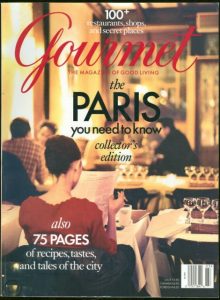 There were several descriptions of lavish travel in this memoir– we were amazed at how many people were needed to put together an article on, say, Paris; but the real stunner was the way these trips happened, with no expense spared. From restaurants to hotels, it was all over the top in a way that was hard to envision. Later in the book, as it becomes clear that the magazine may be doomed, there’s a final trip to Paris on a budget– and this was of course much more relatable. And the author makes the valid point that meals don’t have to be elaborate to be superb, and a hotel you’re only using for sleeping doesn’t have to be five-star to be comfortable. I guess it’s all what you’re used to!
There were several descriptions of lavish travel in this memoir– we were amazed at how many people were needed to put together an article on, say, Paris; but the real stunner was the way these trips happened, with no expense spared. From restaurants to hotels, it was all over the top in a way that was hard to envision. Later in the book, as it becomes clear that the magazine may be doomed, there’s a final trip to Paris on a budget– and this was of course much more relatable. And the author makes the valid point that meals don’t have to be elaborate to be superb, and a hotel you’re only using for sleeping doesn’t have to be five-star to be comfortable. I guess it’s all what you’re used to!
We’d definitely recommend this or any of Ruth Reichl’s memoirs– they’re a nice mix of the lighthearted and the serious, the triumphs and defeats, the mundane and the incredible. We enjoy this author’s highly readable style, which makes these books hard to put down. Most of us do prefer her earlier titles about her growing-up years, and of course we loved the humor that’s so evident in Garlic and Sapphires, but Save Me the Plums is worth your time as well. Our zoom meeting was unfortunately interrupted by a power failure (affecting a good-sized portion of the town), so voting was a bit spotty; but of those who voted, the memoir averaged out to 4.2; the magazine 1.9!
Though we may not have done much cooking in February, things will be heating up this month as we explore the ever-popular topic of pizza. Choose from either Truly Madly Pizza by Suzanne Lenzer or Todd English’s Rustic Pizza by local chef Todd English. Both are available at the main circulation desk or via curbside pickup. We’ll next meet via zoom on Friday March 26 at 11 AM; if you’re not already on our mailing list and would like to attend, please email group leader Andrea Grant.
News flash: if you loved Gourmet and/or Ruth Reichl’s memoir, we’ll soon have available a Binge Box with a year’s worth of issues plus a copy of the memoir. Great reading, and cooking, for a rainy day!
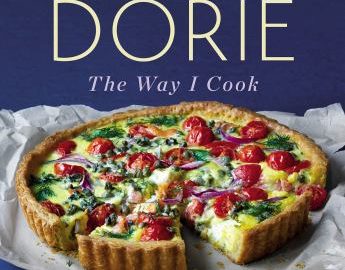
Bibliobites in January: My Dinner With Dorie
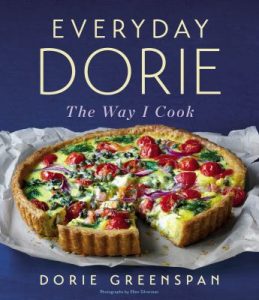 What do you get when you combine cold weather, short days, a long stretch between meetings, an ongoing pandemic that has most of us at home almost all the time, and a cookbook filled with dinner ideas? You get a lot of cooking going on, so buckle up, folks– this could be a long ride!
What do you get when you combine cold weather, short days, a long stretch between meetings, an ongoing pandemic that has most of us at home almost all the time, and a cookbook filled with dinner ideas? You get a lot of cooking going on, so buckle up, folks– this could be a long ride!
This month’s title, Everyday Dorie by Dorie Greenspan, did seem to be peculiarly suited to the time of year and the circumstances in which we find ourselves. The theme of this book is casual meals that the author whips up on any given weeknight. Though the emphasis is on main dishes, there are appetizers, side dishes, and desserts as well. There’s even a chapter at the end on basics, that covers projects (some simple, some more elaborate) that you might feel like tackling if, I don’t know, you were in your house all the time.
The book itself is a nice hefty squarish tome; the shape meant that the pages were wider than the norm, and happily the book stayed flat no matter where it was opened. There are plenty of beautiful, up-close photos, and the pages feature ample white space and easy-to-read type. At the end of most recipes there’s information on storing and reheating, as well as serving ideas and ways to, as the author says, “play around” with the ingredients. There were also plenty of verbose headnotes; and while some don’t enjoy these short prequels, at least here they were mostly in the form of tips for success, and not the name- or place-dropping that has become so common. On the other hand, had the headnotes not been so lengthy, many more of the recipes could have each fit on one page, a most desirable feature. Book editors, please take note!
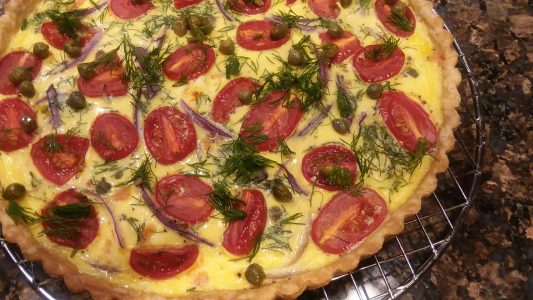 As mentioned, there were major amounts of cooking going on, so let’s get to it. A few recipes caught the eye of several members, and these proved to be among the best-liked. The recipe shown on the book’s cover, lower east side brunch tart, was one of these winners. There was praise for the tart dough, which was easy to work with (including the “great idea” to roll out between 2 sheets of parchment paper) and baked up nicely. We enjoyed the filling’s creamy combo of smoked salmon, cream cheese, capers, and dill. This recipe seemed more special-occasion than everyday, but definitely worth the time and expense. The
As mentioned, there were major amounts of cooking going on, so let’s get to it. A few recipes caught the eye of several members, and these proved to be among the best-liked. The recipe shown on the book’s cover, lower east side brunch tart, was one of these winners. There was praise for the tart dough, which was easy to work with (including the “great idea” to roll out between 2 sheets of parchment paper) and baked up nicely. We enjoyed the filling’s creamy combo of smoked salmon, cream cheese, capers, and dill. This recipe seemed more special-occasion than everyday, but definitely worth the time and expense. The  mushroom-bacon galette was without a doubt a keeper. There was lavish praise for the filling (“I could’ve just eaten that”) with its savory and smoky notes; and the crust (slightly different from that of the brunch tart) was flaky and tasty. This crust had a bit of sugar, which seemed a little odd, but “it worked!” Overall, it was just “fantastic– one of the best recipes I’ve ever made!”
mushroom-bacon galette was without a doubt a keeper. There was lavish praise for the filling (“I could’ve just eaten that”) with its savory and smoky notes; and the crust (slightly different from that of the brunch tart) was flaky and tasty. This crust had a bit of sugar, which seemed a little odd, but “it worked!” Overall, it was just “fantastic– one of the best recipes I’ve ever made!”
Since it’s winter, we made lots of soups and stews. Moroccan-spiced chickpea and noodle soup was “really hearty” and made a big potful. Though the recipe contained meatballs, the general consensus was that they weren’t necessary, and anyway they were “too plain.” Those who made this liked it enough that they would make it again; but one big flaw was that it called for 3 tablespoons of ground ginger; the general reaction was, “no way!” We decided it must be a typo; but even cutting back to 2 teaspoons or less, there was plenty of spice; the recipe calls for several others besides the ginger. Another soup that featured meatballs, gingered-turkey meatball soup was a comforting, Asian-inspired bowl. It did need the optional add-ins to amp up the flavors, but this was easily done and would enable diners to customize to taste. Though the author claims it doesn’t make a good leftover, we found the opposite to be true: those who made it felt it got better with age. Roasted butternut squash soup turned out to be “OK– but not great.” The method of roasting the squash, with the skin on (which you then had to peel off after baking) seemed unnecessarily awkward and messy, especially since a sticky mixture of oil, maple syrup, and soy sauce was poured over the squash before roasting (“be sure to line the pan with foil like she says!”). 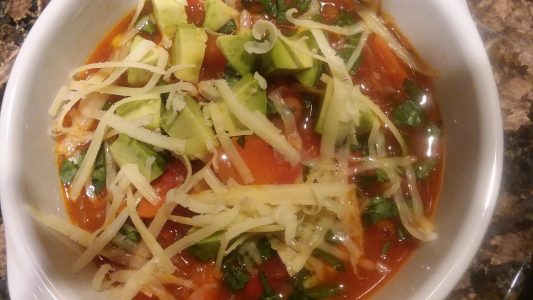 Bean and tortilla soup was also just “OK.” Multiple toppers were listed at the end of the recipe, but even with these added, in the end it was “kind of boring.”
Bean and tortilla soup was also just “OK.” Multiple toppers were listed at the end of the recipe, but even with these added, in the end it was “kind of boring.”
There’s a chapter devoted to chicken, and this was a popular choice for many. Three people made “super simple” sweet chili chicken thighs. One person loved them; for another they were OK; and for the third the sauce tasted bitter (this is starting to sound like Goldilocks!). Ponzu chicken was another easy dish with an Asian twist; in this case the salty/ lemony Ponzu sauce was a good foil for the chicken.  Lemon-fennel chicken in a pot took its namesake flavor from fresh lemons, but in this case the lemon was “overpowering.” The fennel taste was assertive, but those of us who like fennel were happy about that. Altogether, this was a straightforward, tasty braise; but next time we’ll use less lemon. Spatchcocked chicken was as good as any roast chicken, though nothing extraordinary. However, it’s a great technique to use and fun to say!
Lemon-fennel chicken in a pot took its namesake flavor from fresh lemons, but in this case the lemon was “overpowering.” The fennel taste was assertive, but those of us who like fennel were happy about that. Altogether, this was a straightforward, tasty braise; but next time we’ll use less lemon. Spatchcocked chicken was as good as any roast chicken, though nothing extraordinary. However, it’s a great technique to use and fun to say!
In the fish category, one hit was the cod and beans en papillote. Though the individual foil packets were a bit fussy to put together, the combination of beans, fish, and tomatoes was a bit different and delicious. This was another recipe that aged well (at least for a few days) despite the author’s claims that “there is no keeping this dish once it is cooked.” Seafood pasta pulled out all the stops with fish, shrimp, and squid; but the result was “eh!” And it really needed the lemon, despite it being listed at the end as optional. More lemon appeared (I’m sensing a trend here) in 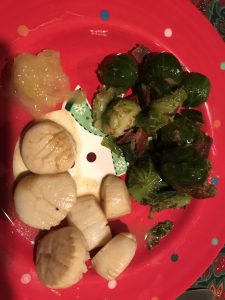 twice-flavored scallops; in addition to lemon juice, lemon goop garnishes the scallops once cooked. The goop is “custardy” (like a lemon curd); it was easy to make and kept well.
twice-flavored scallops; in addition to lemon juice, lemon goop garnishes the scallops once cooked. The goop is “custardy” (like a lemon curd); it was easy to make and kept well.
Additional main dishes we tried included bourbon-roasted pork loin (“really good”), umami burgers (“I needed many new condiments…super-tender, liked the veggies in it”), and pasta with cabbage, winter squash, and walnuts (“OK– it looked pretty; liked the dried cranberries”). A couple of recipes turned out to be projects: stuffed cabbage, after a lot of work, was “disappointing– the sauce was too sweet and I didn’t like the lemon in the filling.” That good old standby, spaghetti and meatballs, was a delicious version of this classic; adding sausage to the meatballs was a yummy twist. As the recipe states, the meatballs “drink up the sauce,” but that meant there wasn’t quite enough left for the spaghetti.
Even after all those main dishes, we still had some energy left for sides, like gingered beet salad (“it was fine”), 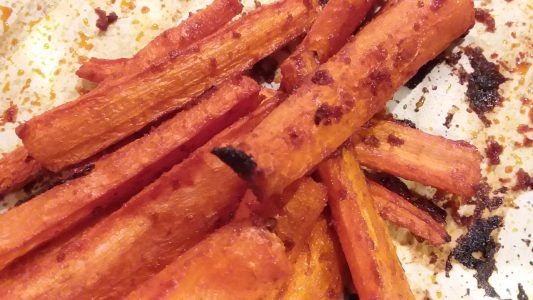 sweet and smoky roasted carrots (“very good, different– love the smoked paprika in these”), and cowboy caviar or side (“not a good leftover because of the fresh tomatoes– but I would make it again”). Three people made maple syrup and mustard brussels sprouts; this was “good, but used too many pots.” The syrup and mustard have become a classic pairing for brussels sprouts, and it’s a “go-to” combination for one person. Another changed up the recipe significantly, adding in raisins and apple, which was “fabulous.” One big flop was the oven-charred tomato-stuffed peppers. Though this is one of the author’s signature recipes, it was not as advertised; the bread crumbs got unpleasantly soggy inside the pepper halves, and the lemon slice atop the crumbs never cooked and was overly chewy. The photo looks “fabulous– but don’t bother.” Roasted squash hummus also sounded enticing, but it was “bland” and “looked like something you get from a newborn baby’s diaper.” I note that there is no photo of this particular recipe!
sweet and smoky roasted carrots (“very good, different– love the smoked paprika in these”), and cowboy caviar or side (“not a good leftover because of the fresh tomatoes– but I would make it again”). Three people made maple syrup and mustard brussels sprouts; this was “good, but used too many pots.” The syrup and mustard have become a classic pairing for brussels sprouts, and it’s a “go-to” combination for one person. Another changed up the recipe significantly, adding in raisins and apple, which was “fabulous.” One big flop was the oven-charred tomato-stuffed peppers. Though this is one of the author’s signature recipes, it was not as advertised; the bread crumbs got unpleasantly soggy inside the pepper halves, and the lemon slice atop the crumbs never cooked and was overly chewy. The photo looks “fabulous– but don’t bother.” Roasted squash hummus also sounded enticing, but it was “bland” and “looked like something you get from a newborn baby’s diaper.” I note that there is no photo of this particular recipe!
And last, we come to desserts. Cornmeal buttermilk loaf cake was a bit too dense (possibly needed more leavening?), but it was excellent toasted. Apple custard crisp had too much streusel on top of the apples; it never browned but instead turned into “a big dry mass.” But the big winner in the dessert section was the dark chocolate pudding, which was incredibly silky with fantastic chocolate flavor. After hearing how good this was, I think we were all ready to whip out a saucepan and make some! I know it’s on my list of future desserts to try.
If you’ve read this far, it should be obvious by now that we gave this book a thorough test-drive. Some commonalities emerged: lots of Asian flavors and condiments; a preponderance of lemon; a wide variety of spices. Some recipes seemed too time-consuming or labor-intensive to be called “everyday,” though there certainly were simpler ideas as well. In once again reviewing our discussion and the book I concluded that (as the subtitle indicates) this is a rather personal book for the author, and if you like her style, you’re all set. Just be sure you like lemons!! But seriously, we enjoyed this title and I think all of us came away with a few keepers. Two people even bought the book, which doesn’t happen that often. In the end, our voting averaged out to 3.3, out of a possible 5. That’s actually a pretty decent score for this group.
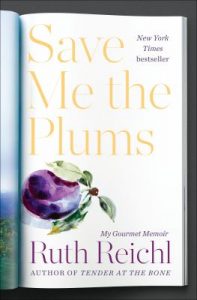 Our next meeting will be on Friday February 26 at 11 AM. We’ll chat via Zoom; if you aren’t already on our mailing list, please email group leader Andrea Grant. This month we’ll be taking a little break from cooking with Ruth Reichl’s most recent memoir, Save Me the Plums, which covers her years as editor-in-chief of Gourmet magazine. Copies are available at the main circulation desk or via curbside pickup.
Our next meeting will be on Friday February 26 at 11 AM. We’ll chat via Zoom; if you aren’t already on our mailing list, please email group leader Andrea Grant. This month we’ll be taking a little break from cooking with Ruth Reichl’s most recent memoir, Save Me the Plums, which covers her years as editor-in-chief of Gourmet magazine. Copies are available at the main circulation desk or via curbside pickup.
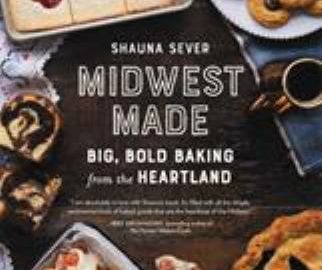
Bibliobites in December: Midwest Meh
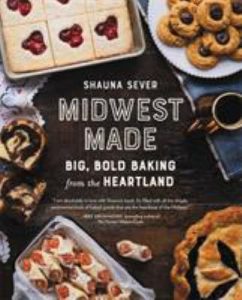 Often the culinary world seems to be neatly divided between those who love to cook, and those who have a passion for baking. Those on the savory side appreciate the more-improvisational nature of cooking– the freedom to alter on the fly and go where whim and ingredients take them. For those with this view, baking is simply too fussy and time consuming; or they (inexplicably) don’t care about sweets. Bakers, on the other hand, are calmed by the precise nature of measuring or weighing, and enjoy combining that classic quartet of flour, sugar, butter, and eggs in infinite ways. In December, our Bibliobites group tackled Midwest Made by Shauna Sever, a baking book focused on (as the subtitle says), big, bold baking from the heartland. Though this book features some savory bakes, it’s mostly about the sugar. And, as it turns out, nearly all in our group consider themselves cooks rather than bakers, so how did it all go down?
Often the culinary world seems to be neatly divided between those who love to cook, and those who have a passion for baking. Those on the savory side appreciate the more-improvisational nature of cooking– the freedom to alter on the fly and go where whim and ingredients take them. For those with this view, baking is simply too fussy and time consuming; or they (inexplicably) don’t care about sweets. Bakers, on the other hand, are calmed by the precise nature of measuring or weighing, and enjoy combining that classic quartet of flour, sugar, butter, and eggs in infinite ways. In December, our Bibliobites group tackled Midwest Made by Shauna Sever, a baking book focused on (as the subtitle says), big, bold baking from the heartland. Though this book features some savory bakes, it’s mostly about the sugar. And, as it turns out, nearly all in our group consider themselves cooks rather than bakers, so how did it all go down?
 Let’s start with the good news: buckeye bars were an easy no-bake treat with the classic combination of peanut butter and chocolate. They were rich and fudgy, “almost like peanut butter fudge.” Peanut butter was also a hit in the scotch-a-roos, a riff on rice krispie treats; “I have already made three batches!” Sounds like a keeper. White fruitcake was likewise a twist on a classic, if much-maligned cake; it was lightened with meringue and “turned out exactly as the picture in the book…I will be using it as my Christmas cake from now on.” Though it wasn’t zucchini season anymore, double chocolate zucchini loaf was “the best” use of this abundant vegetable. It had good dark chocolate flavor, was moist and kept well. Donut loaf was an intriguing idea– a loaf cake that the recipe claimed would taste just like a powdered sugar donut– and it did! If you are a donut fan this is a delicious and easy way to get your fix. Even better, it uses ingredients you’re likely to have in the house. Jammy fruit and browned butter bars were a hit and a miss: one person thought this combo of fruit and crumbly topping was just right, but another found the crust and topping to be “quite dense.” Unadorned
Let’s start with the good news: buckeye bars were an easy no-bake treat with the classic combination of peanut butter and chocolate. They were rich and fudgy, “almost like peanut butter fudge.” Peanut butter was also a hit in the scotch-a-roos, a riff on rice krispie treats; “I have already made three batches!” Sounds like a keeper. White fruitcake was likewise a twist on a classic, if much-maligned cake; it was lightened with meringue and “turned out exactly as the picture in the book…I will be using it as my Christmas cake from now on.” Though it wasn’t zucchini season anymore, double chocolate zucchini loaf was “the best” use of this abundant vegetable. It had good dark chocolate flavor, was moist and kept well. Donut loaf was an intriguing idea– a loaf cake that the recipe claimed would taste just like a powdered sugar donut– and it did! If you are a donut fan this is a delicious and easy way to get your fix. Even better, it uses ingredients you’re likely to have in the house. Jammy fruit and browned butter bars were a hit and a miss: one person thought this combo of fruit and crumbly topping was just right, but another found the crust and topping to be “quite dense.” Unadorned  golden almond cookies were a pleasant, not-too-sweet cookie with assertive almond flavor, but the beaten egg yolk brushed on top before baking was too thick– it would have been better had the recipe instructed you to dilute the yolk with water before using. Simple bran muffins were straightforward, but you had to buy bran flake cereal to make them; they were “just OK– but I prefer my go-to recipe that features molasses.” Didn’t know bran muffins without molasses even existed! And one big flop was the crispy iced oatmeal flats which “tasted like cardboard.” ‘Nuff said!
golden almond cookies were a pleasant, not-too-sweet cookie with assertive almond flavor, but the beaten egg yolk brushed on top before baking was too thick– it would have been better had the recipe instructed you to dilute the yolk with water before using. Simple bran muffins were straightforward, but you had to buy bran flake cereal to make them; they were “just OK– but I prefer my go-to recipe that features molasses.” Didn’t know bran muffins without molasses even existed! And one big flop was the crispy iced oatmeal flats which “tasted like cardboard.” ‘Nuff said!
There is a chapter titled “Savories,” and some of our avowed non-bakers focused on that. Nebraskan runzas were a filled bun; the filling of ground beef, cheese, and cabbage was a yummy complement to the soft yeasted dough surrounding it. These were a bit fussy to make but worth the effort (and the recipe makes 12!). English muffin bread looked just like its picture; it had the requisite holes and made excellent toast.  Big soft pretzels were time-consuming, but they came out tasting like those buttery mall pretzels. They were even good reheated the next day in the oven, but because of the painstaking process, “I don’t think I would make them again.”
Big soft pretzels were time-consuming, but they came out tasting like those buttery mall pretzels. They were even good reheated the next day in the oven, but because of the painstaking process, “I don’t think I would make them again.”
On the downside, smoky cheddar-crusted cornish pasties were “a bit dry” and needed a side of ketchup for dunking. But the pastry was interesting, as it used a bit of vinegar for tenderizing. Blue cheese and scallion cornbread was also dry and “you couldn’t taste the cheese,” a flaw that also appeared (despite using extra-sharp cheddar) in the brewers’ cheddar bread. Brown Irish soda bread was an unmitigated flop: “it was dense, heavy, and didn’t taste good.”
It should be obvious by now that we went all-in, approaching our baking with gusto. But for most, this title just didn’t make the grade. As I reviewed everyone’s comments, it seemed that the majority had a fairly successful experience; but somehow we weren’t too impressed. Part of this may be due to the style of the recipes, and for some the problem was the quantities. Almost all of the recipes make a decent-sized batch; and as we learned in September, most of us live in smaller households. So, too much of a pretty good thing? And, of course, several in the group mentioned that they are not bakers; so it’s an uphill battle from the get-go.
Interestingly, this book made quite a splash when it was published in early 2019, earning rave reviews and gushing quotes from notable bakers and authors. It’s been widely praised for its homespun and user-friendly recipes, as well as its practical, no-fuss approach. The author’s tone is friendly and chatty; she’s clearly passionate about her Midwestern roots, and the diversity to be found in an area many coastal types see as characterless. Ms. Sever may have wowed the critics, but unfortunately she didn’t win us over: our voting averaged out to a 2.1, our lowest score in a long time.
 Our next meeting will be on Friday, January 29 at 11 AM. We’ll chat via Zoom; if you aren’t already on our mailing list and would like to attend, please email group leader Andrea Grant. We’ll be cooking, and maybe not baking, this month from Dorie Greenspan’s Everyday Dorie. Copies are available at the main circulation desk.
Our next meeting will be on Friday, January 29 at 11 AM. We’ll chat via Zoom; if you aren’t already on our mailing list and would like to attend, please email group leader Andrea Grant. We’ll be cooking, and maybe not baking, this month from Dorie Greenspan’s Everyday Dorie. Copies are available at the main circulation desk.
Happy New Year to all!

Bibliobites in October: Back to the Garten
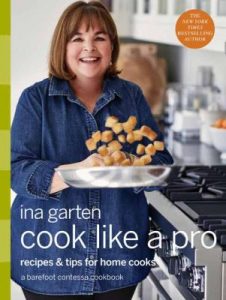 The Barefoot Contessa (a.k.a. Ina Garten) has amazing staying power. After almost four decades in the food business, with twelve bestselling cookbooks and numerous TV shows, she is easily one of the most successful authors in the food world. Her devoted fans are legion, and they love her warm, approachable personality as much as her iconic recipes. Our Bibliobites group enjoyed an earlier title of hers, back in 2016; and last month we returned to Contessa-land to try out one of her more recent titles: Cook Like a Pro (her newest book, Modern Comfort Food, was released in October of this year). Plenty of titles for the home cook claim that they will turn us into expert chefs– did this one really improve our skills?
The Barefoot Contessa (a.k.a. Ina Garten) has amazing staying power. After almost four decades in the food business, with twelve bestselling cookbooks and numerous TV shows, she is easily one of the most successful authors in the food world. Her devoted fans are legion, and they love her warm, approachable personality as much as her iconic recipes. Our Bibliobites group enjoyed an earlier title of hers, back in 2016; and last month we returned to Contessa-land to try out one of her more recent titles: Cook Like a Pro (her newest book, Modern Comfort Food, was released in October of this year). Plenty of titles for the home cook claim that they will turn us into expert chefs– did this one really improve our skills?
Cook Like a Pro is the same size and design as all her other books, but that’s a good thing! It’s a nice size (perhaps a bit smaller than many other current titles); the glossy, heavy pages feature easy-to-read type and generous white space. It’s lavishly illustrated with a full-page, drool-worthy photo of almost every recipe. The pages lie flat no matter where you open the book; this is due to its unique binding, a feature found in all of Garten’s books, and one much appreciated by our group. Almost all of the recipes include a sidebar “pro tip,” designed to teach a cooking technique or prep method that will take your cooking to the next level.
One of Garten’s main claims to fame is the utter reliability of her recipes, which are typically extensively tested, tweaked and refined. When we got into the kitchen, we found that, for the most part, her recipes were indeed pretty foolproof. These days there’s often ample time to cook, as we are all home more; and, as one person remarked, “I was bored so I cooked a lot.” The vast majority of what we made were main dishes, though one cook tried an appetizer of sauteed shishito peppers, which were simple and tasty. In Garten’s newest book she revisits this recipe and adds a dipping sauce, which definitely kicked it up a notch. This seems to be a theme of the author’s: she often repeats recipes, perhaps with a new twist or additional ingredients; this can be annoying or endearing, depending on who you talk to. But I digress!
sauteed shishito peppers, which were simple and tasty. In Garten’s newest book she revisits this recipe and adds a dipping sauce, which definitely kicked it up a notch. This seems to be a theme of the author’s: she often repeats recipes, perhaps with a new twist or additional ingredients; this can be annoying or endearing, depending on who you talk to. But I digress!
Back in the kitchen we launched into our main dishes with great energy and enthusiasm: two people made pork posole, which had many praiseworthy attributes. It was good for a group, it aged well, and it was nicely thickened with crushed tortilla chips. The garnish of refreshing, crunchy sliced radishes was a pleasing topper. At least three people made chicken thighs with creamy mustard sauce, 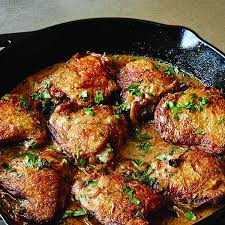 which was “good,” though it could have used more mustard. On the downside, browning the chicken made “a huge mess,” and the recipe took longer to cook than was indicated, a quirk that occurred with other recipes as well. Staying with poultry, two of us made crispy mustard chicken, which was also not very mustard-y. This version was good but not great, and similar to others we’d had. The chicken was topped with a thick layer of panko breadcrumbs mixed with herbs and seasonings; the layer was so thick it seemed “like stuffing on top of chicken” rather than just a crispy crust.
which was “good,” though it could have used more mustard. On the downside, browning the chicken made “a huge mess,” and the recipe took longer to cook than was indicated, a quirk that occurred with other recipes as well. Staying with poultry, two of us made crispy mustard chicken, which was also not very mustard-y. This version was good but not great, and similar to others we’d had. The chicken was topped with a thick layer of panko breadcrumbs mixed with herbs and seasonings; the layer was so thick it seemed “like stuffing on top of chicken” rather than just a crispy crust.
Panko made multiple appearances in this book: rack of lamb was heavily coated with it, which made for a mess when you carved the meat. But, it was “cooked perfectly” and was a delicious splurge. Another special-occasion dish, 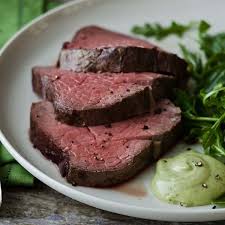 filet of beef, always turns out perfectly “if you follow the recipe exactly.” It’s easy to make, is absolutely delicious, and a real showstopper. This recipe is one of Garten’s signature dishes, and appears in all of her cookbooks! Another pricey option, cioppino, was unfortunately an “expensive flop!” The fennel taste was too strong, and the broth was too thin. But if you really like fennel this could be the dish for you, as long as you don’t mind spending “about a million bucks” on a variety of seafood.
filet of beef, always turns out perfectly “if you follow the recipe exactly.” It’s easy to make, is absolutely delicious, and a real showstopper. This recipe is one of Garten’s signature dishes, and appears in all of her cookbooks! Another pricey option, cioppino, was unfortunately an “expensive flop!” The fennel taste was too strong, and the broth was too thin. But if you really like fennel this could be the dish for you, as long as you don’t mind spending “about a million bucks” on a variety of seafood.
Coming back down to earth a bit, three people made flounder milanese,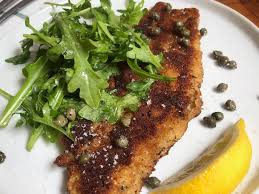 which was “surprisingly good.” This was a straightforward combination of lightly breaded fillets accented with lemon and capers, garnished with a simple arugula salad. Pork souvlaki was easy and tasty, but what put it over the top was the “pretty fabulous” radish tzatziki. Garten’s take on the classic chicken marbella wasn’t really very updated, as the recipe claimed. A couple of small differences: the method is a bit simpler, and the ingredients include “more of everything.” However, like all versions of this dish, it was absolutely delicious. Two people made tomato and eggplant soup, which both agreed was “just OK.” You can use leftover soup as a sauce in baked pasta with tomatoes and eggplant, which was also pretty basic. These two recipes did not live up to pro standards!
which was “surprisingly good.” This was a straightforward combination of lightly breaded fillets accented with lemon and capers, garnished with a simple arugula salad. Pork souvlaki was easy and tasty, but what put it over the top was the “pretty fabulous” radish tzatziki. Garten’s take on the classic chicken marbella wasn’t really very updated, as the recipe claimed. A couple of small differences: the method is a bit simpler, and the ingredients include “more of everything.” However, like all versions of this dish, it was absolutely delicious. Two people made tomato and eggplant soup, which both agreed was “just OK.” You can use leftover soup as a sauce in baked pasta with tomatoes and eggplant, which was also pretty basic. These two recipes did not live up to pro standards!
This book features some delicious salads and side dishes, which for me were among the strongest recipes in the book. Chicken and spinach waldorf salad was a keeper; it was “like waldorf salad on steroids.” It did have numerous ingredients but our cook happened to have most on hand, so it was an easy dish to put together. Israeli vegetable salad was crisp and refreshing, although “mine didn’t look so pretty (as the photo).” Tomato avocado salad was also quite good, but it made a lot and doesn’t keep well, so you may need to adjust quantities. 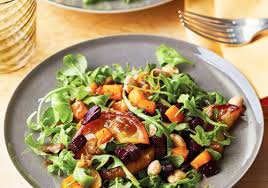 Roasted beet, squash, and apple salad was a different and yummy combination of fall ingredients; likewise charlie bird’s farro salad was unique and flavorful, with its garnishes of pistachio and mint. The farro was cooked in apple cider which added an unusual but welcome sweetness.
Roasted beet, squash, and apple salad was a different and yummy combination of fall ingredients; likewise charlie bird’s farro salad was unique and flavorful, with its garnishes of pistachio and mint. The farro was cooked in apple cider which added an unusual but welcome sweetness.
In the cooked vegetable department, orange carrots were super-simple but delectable, the sharp citrus perfectly accenting the sweet carrots. Roasted broccoli with panko with its crunchy charred edges made this everyday vegetable a little more special. This was one of those recipes where the timing was off; the broccoli definitely took more time than the recipe indicated. Celery root and chickpea puree was “just terrific!” This simple combo makes a great foil for any meaty main dish. The celery root is subtle but just different enough to wake up your taste buds. Another keeper was the 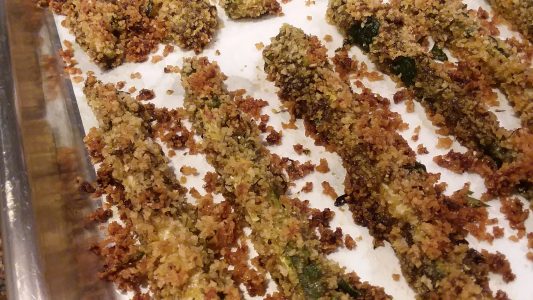 parmesan pesto zucchini sticks, which would instantly convert any zucchini hater. The combination of pesto and parmesan, along with the crunchy panko and plenty of salt, turned the mild zucchini into an umami bomb. Warm brown rice and butternut squash was a savory way to turn rice and squash into a substantial side or lighter main dish. With its squash and dried cranberries it would happily grace anyone’s Thanksgiving table.
parmesan pesto zucchini sticks, which would instantly convert any zucchini hater. The combination of pesto and parmesan, along with the crunchy panko and plenty of salt, turned the mild zucchini into an umami bomb. Warm brown rice and butternut squash was a savory way to turn rice and squash into a substantial side or lighter main dish. With its squash and dried cranberries it would happily grace anyone’s Thanksgiving table.
This book has a breakfast chapter; shakshuka with feta was good, and the addition of feta a nice touch; but the recipe had too much fennel for our group member (fennel seems to be one of those flavors you either love or despise). Two people made morning glory muffins, which were “really good!” The recipe stated it made 14 muffins but both cooks reported that they made 24! However the muffins stayed fresh for more than a few days so it wasn’t really a problem. Once again, no one tackled any desserts; but those familiar with Garten’s recipes love her blueberry crumb cake and her 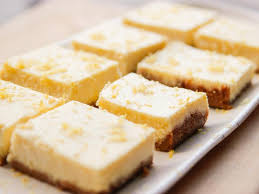 limoncello cheesecake squares. Though they weren’t in the book, both of these are very easy to find online; Garten is generous with her work, making many recipes available through her website and other online sources.
limoncello cheesecake squares. Though they weren’t in the book, both of these are very easy to find online; Garten is generous with her work, making many recipes available through her website and other online sources.
So, did we learn to “cook like a pro”? Most of us love the Contessa and enjoy cooking from her books, but the overall consensus was that this title was a little sub-par. Many of the “pro tips” seemed obvious and/or common sense, though they could be helpful for someone without a lot of experience in the kitchen. The book also had some noticeable quirks, among them a major reliance on certain ingredients, like panko, fennel, and creme fraiche. She also uses salt with a very heavy hand, both as seasoning and garnish. In baking she uses extra-large eggs, which are a much less common, and sometimes less available, choice than the standard “large.” A few of us were annoyed by her specifying brands of ingredients and cookware, and we wondered if that was what she really prefers, or it’s just advertising.
But quirks aside, we like the Contessa for her super-reliable and not too time-consuming recipes. And most of the time she uses ingredients that are readily available, even if they sometimes are more expensive than average. Accordingly, our rating was higher than usual, averaging out to 3.71 (out of a possible 5). That’s a strong score for this group!
If you enjoy reading about/cooking from Ina Garten’s books, check out this link. It’s a Food52 article about a slightly obsessed fan! Thank you Carole for bringing this to my attention.
 We’ll next meet on Friday December 4 at 11 AM; plan to chat via Zoom. Please note that we are meeting on the first Friday of December– this is a combined November/December meeting. We’ll be discussing Shauna Sever’s Midwest Made, a baking book exploring homey classics as well as ethnic specialties. Copies are available at the main desk or via curbside pickup.
We’ll next meet on Friday December 4 at 11 AM; plan to chat via Zoom. Please note that we are meeting on the first Friday of December– this is a combined November/December meeting. We’ll be discussing Shauna Sever’s Midwest Made, a baking book exploring homey classics as well as ethnic specialties. Copies are available at the main desk or via curbside pickup.
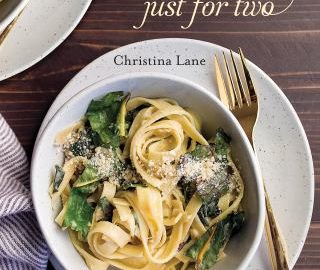
Bibliobites in September: TwoFer
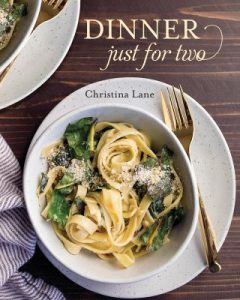 Table for two….tea for two….like two peas in a pod….it takes two to tango. Coupledom is celebrated in our culture, but not so much in the kitchen. Most recipes typically serve four or six, which can be problematic for a small household. While it’s convenient to have tasty leftovers in your fridge, how many times do you really want to eat any particular dish? The leftover problem is sometimes a consequence of the shopping problem– that is, packaging is frequently “family sized,” and buying in smaller quantity is either not an option or is more expensive. Considering that, according to the 2010 US census, 28% of us live singly and 34% of us are couples (so over 60% of us live in small households!), it’s surprising how much the food/cooking world still focuses on larger quantities. That seems to be shifting a bit, at least in cookbooks; and this month our Bibliobites group test drove three titles devoted to small batch cooking, all by blogger Christina Lane: Dinner Just For Two; Comfort and Joy: Small Batch Meals For Every Occasion; and Desserts For Two. Have we embraced the smallish and ditched the leftovers?
Table for two….tea for two….like two peas in a pod….it takes two to tango. Coupledom is celebrated in our culture, but not so much in the kitchen. Most recipes typically serve four or six, which can be problematic for a small household. While it’s convenient to have tasty leftovers in your fridge, how many times do you really want to eat any particular dish? The leftover problem is sometimes a consequence of the shopping problem– that is, packaging is frequently “family sized,” and buying in smaller quantity is either not an option or is more expensive. Considering that, according to the 2010 US census, 28% of us live singly and 34% of us are couples (so over 60% of us live in small households!), it’s surprising how much the food/cooking world still focuses on larger quantities. That seems to be shifting a bit, at least in cookbooks; and this month our Bibliobites group test drove three titles devoted to small batch cooking, all by blogger Christina Lane: Dinner Just For Two; Comfort and Joy: Small Batch Meals For Every Occasion; and Desserts For Two. Have we embraced the smallish and ditched the leftovers?
Most in the group do live in one- or two-person households, so this topic is relevant; and since we’re all cooking at home almost all the time, we can always use some inspiration. So, there was a lot of cooking going on! Dinner Just For Two was the clear winner in this group; there weren’t too many complaints about any of the recipes we tried. Among the hits were French lentils and kielbasa, baked Greek shrimp, chicken Parmesan meatballs (“I liked it a lot!”), corn, tomato, and dill summer salad, tandoori chicken (“one of the best…so moist and flavorful!”), and cheddar scallion waffles (“a nice, savory [versus sweet] option”). 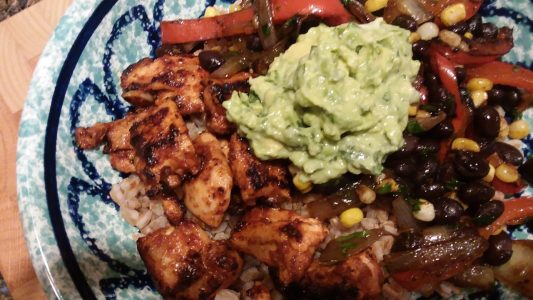 This book features several recipes for bowls, which were also standouts: we enjoyed egg roll in a bowl (“love it…like the crunchy topper”), coconut curry noodle bowl (“very good!”), peanut lime noodle bowl (“I really liked the sauce”), chicken burrito bowl, roasted potato bowls with broccoli and gribiche (“the sauce puts it over the top!”), and
This book features several recipes for bowls, which were also standouts: we enjoyed egg roll in a bowl (“love it…like the crunchy topper”), coconut curry noodle bowl (“very good!”), peanut lime noodle bowl (“I really liked the sauce”), chicken burrito bowl, roasted potato bowls with broccoli and gribiche (“the sauce puts it over the top!”), and 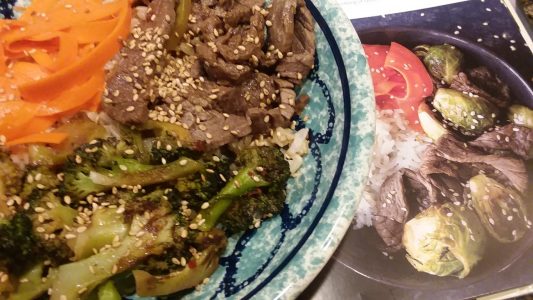 almost Korean beef bowls. All the bowls were praised for solid flavors and ease of preparation.
almost Korean beef bowls. All the bowls were praised for solid flavors and ease of preparation.
Though the book unsurprisingly focuses on dinner, there is a dessert chapter, and some breads as well. No-knead Dutch oven bread was super-easy and came out “just like the recipe said it would!” On the other hand, foccacia was “very bland…it needed something more than just rosemary.” Espresso chocolate-chip cookies were tasty though they could have used a bit more coffee flavor; mini chocolate cake definitely had the cute factor, but was unexceptional otherwise. But the raspberry brownies with Chambord glaze were excellent– chewy and chocolatey with a nice hit of raspberry.
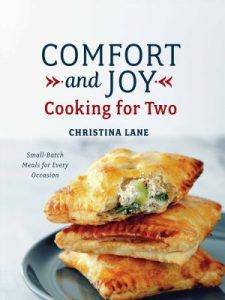 Several in the group had cooked out of Comfort and Joy; and the results from this title were decidedly uneven. There were some hits: two people loved the green chile chili, which made two big bowls of this simple stew. It was strongly flavored with cumin, which one person felt was way too much, but overall it was well-liked. To go with your chili, you could try a small batch of corn muffins, which produced 6 tasty muffins. Angel biscuits and gravy was a “good” version of this classic, as was the chicken parmesan for two, which was easy to make and featured a “really good” sauce (helped along by homegrown tomatoes!). Two people enjoyed apricot-pecan chicken salad; this was a yummy combination, but what really put it over the top was the “terrific” mustard-honey dressing. A keeper! From the breakfast chapter, one person made a “delicious” pumpkin spice latte.
Several in the group had cooked out of Comfort and Joy; and the results from this title were decidedly uneven. There were some hits: two people loved the green chile chili, which made two big bowls of this simple stew. It was strongly flavored with cumin, which one person felt was way too much, but overall it was well-liked. To go with your chili, you could try a small batch of corn muffins, which produced 6 tasty muffins. Angel biscuits and gravy was a “good” version of this classic, as was the chicken parmesan for two, which was easy to make and featured a “really good” sauce (helped along by homegrown tomatoes!). Two people enjoyed apricot-pecan chicken salad; this was a yummy combination, but what really put it over the top was the “terrific” mustard-honey dressing. A keeper! From the breakfast chapter, one person made a “delicious” pumpkin spice latte.  The recipe called for 2 tablespoons of vanilla for two drinks, which seemed, if nothing else, quite expensive. A possible typo? Blueberry muffins were “so delicious– I shared the recipe with several friends,” and peanut butter swirl brownies were “really good, really easy….made two HUGE brownies.” Sounds perfect!
The recipe called for 2 tablespoons of vanilla for two drinks, which seemed, if nothing else, quite expensive. A possible typo? Blueberry muffins were “so delicious– I shared the recipe with several friends,” and peanut butter swirl brownies were “really good, really easy….made two HUGE brownies.” Sounds perfect!
So, that was the good news. There were a number of problematic recipes in Comfort and Joy, among which were some “bland” and “flavorless” chicken ‘n dumplins; sweet and spicy Asian salmon that was “just OK” with “too much sesame oil;” and meatloaf that was also “OK” but had a “boring” glaze. Charred corn tilapia was good enough, but the recipe was so simple that it was ultimately uninteresting; apple cider-glazed chicken breasts was a nice autumnal combination, but was one of a few recipes where the photo, which clearly shows cinnamon sticks, doesn’t match the recipe– where no cinnamon sticks are to be found. Taco salad also had some recipe errors; you first cook your ground beef, set it aside– and then it is never mentioned again. To add insult to injury, the entire dish lacked seasoning and looked “like something the cat would eat.” In the dessert section, warm carrot cakes with cream cheese sauce literally fell flat (and were almost inedible), as the recipe contained no leavening of any kind. The sauce was “delicious,” though!
 Overall, we liked the author’s basic concept, since leftovers can be a mixed blessing. It’s true that if you’re bothering to cook a meal, it doesn’t take much more effort to produce four servings rather than two, and then you’ve got an additional meal at the ready. But sometimes you just want a “one and done,” or you live alone and even a recipe designed for two overstays its welcome. Most of the recipes we tried were simple enough and quick enough that we didn’t mind the lack of leftovers, though most produced (by design) three good-sized servings. The petite option was especially appreciated with desserts. While a big cake and two people might initially sound like fun, it gets stale (!) pretty quickly. So even if we don’t always want to cook sans leftovers, it’s nice to have that choice.
Overall, we liked the author’s basic concept, since leftovers can be a mixed blessing. It’s true that if you’re bothering to cook a meal, it doesn’t take much more effort to produce four servings rather than two, and then you’ve got an additional meal at the ready. But sometimes you just want a “one and done,” or you live alone and even a recipe designed for two overstays its welcome. Most of the recipes we tried were simple enough and quick enough that we didn’t mind the lack of leftovers, though most produced (by design) three good-sized servings. The petite option was especially appreciated with desserts. While a big cake and two people might initially sound like fun, it gets stale (!) pretty quickly. So even if we don’t always want to cook sans leftovers, it’s nice to have that choice.
As for the individual titles, Dinner Just For Two was the favorite (a few planned to buy it), while the quality of Comfort and Joy seemed a few notches lower. There were numerous typos and omissions, and many recipes lacked sufficient seasoning. Oddly enough, no one used the Desserts For Two book, which was Ms. Lane’s original claim to fame via her blog. We agreed that all the books had great production values– large format with heavy paper and easy-to-read typeface, and beautiful and copious photos. Our voting averaged out to a 4 (out of a possible 5) for the preferred Dinner book, and 3.2 for Comfort and Joy— so small is beautiful!
Our next meeting will be on October 30 at 11 AM. We’ll be discussing one of Ina Garten’s more recent titles, Cook Like a Pro. Copies are available at the main desk, or via curbside pickup. We’ll chat via Zoom; if you’re not on our Bibliobites mailing list and would like to attend, please email group leader Andrea Grant. See you then!
Bonus paragraph!
 I asked the group for a favorite cooking- or shopping-for-two tip. Most agreed that the freezer is one of their most important tools. Obviously, you can freeze leftovers; but you can also use it to freeze small packages of meat and poultry that you’ve created from those large “family packs.” It’s also helpful to know which recipes freeze well; you can make those in larger quantity, confident that they’ll be tasty months from now. But, with all your little packages in the freezer, how do you keep track of what’s what? First, label everything! You think you’ll recognize something when you take it out three months from now, but trust me– you won’t! A sharpie is your new best friend for avoiding unidentifiable containers. Next, maintain a freezer inventory of some kind.
I asked the group for a favorite cooking- or shopping-for-two tip. Most agreed that the freezer is one of their most important tools. Obviously, you can freeze leftovers; but you can also use it to freeze small packages of meat and poultry that you’ve created from those large “family packs.” It’s also helpful to know which recipes freeze well; you can make those in larger quantity, confident that they’ll be tasty months from now. But, with all your little packages in the freezer, how do you keep track of what’s what? First, label everything! You think you’ll recognize something when you take it out three months from now, but trust me– you won’t! A sharpie is your new best friend for avoiding unidentifiable containers. Next, maintain a freezer inventory of some kind.  Some of us are into spreadsheets, some use plain old paper and pen, or (genius!) a whiteboard. Whatever you choose, it’s key to keep it up to date, which is sometimes easier said than done.
Some of us are into spreadsheets, some use plain old paper and pen, or (genius!) a whiteboard. Whatever you choose, it’s key to keep it up to date, which is sometimes easier said than done.
Produce can be inventoried as well; try putting a sticky note on the produce bin so you can quickly see what’s lurking in there. To prolong the life of produce, certain items will keep better if washed and prepped, like lettuce (wash, spin dry, store in a plastic bag or box with a slightly damp paper towel) and fresh herbs (ditto). Some veggies can be cut up and stored for several days without ill effect, like broccoli, cauliflower, or carrots.
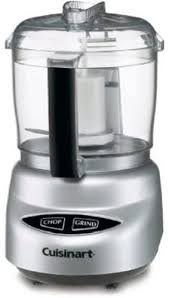 If you’re thinking small with your food, you might as well with your equipment, too. There are mini versions available for stand mixers, food processors, and even multicookers (Instant Pots). It often works better to cook with smaller skillets and saucepans, too. For casseroles and certain desserts, try small au gratin dishes and ramekins. They look appealing, too!
If you’re thinking small with your food, you might as well with your equipment, too. There are mini versions available for stand mixers, food processors, and even multicookers (Instant Pots). It often works better to cook with smaller skillets and saucepans, too. For casseroles and certain desserts, try small au gratin dishes and ramekins. They look appealing, too!
If you are interested in small-batch cooking, check out some of these additional titles:
- The Complete Cooking For Two, by America’s Test Kitchen
- Cooking For One, by America’s Test Kitchen
- Serve Yourself: Nightly Adventures in Cooking For One, by Joe Yonan
- Eat Your Vegetables: Bold Recipes For the Single Cook, by Joe Yonan
- Healthy Instant Pot Mini Cookbook, by Nili Barrett
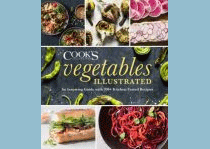
Bibliobites in August: Veg Out!
 What is it about cooking with vegetables that is so satisfying? Is it the visuals– the mind-blowing array of colors, shapes, and textures? Is it the elemental joy of taking an ordinary ingredient and turning it into something full of complex flavor? Is it the fun of being on-trend with the newly-hip produce aisle? Or maybe our bodies and brains are just jazzed on all those vitamins and antioxidants! Whichever it is, the farm stand and produce section beckon like never before, especially in the bountiful month of August. Though our Bibliobites group has tackled the subject of vegetables before, it seemed like a good time to revisit it, and to explore some new titles about this ever-expanding topic.
What is it about cooking with vegetables that is so satisfying? Is it the visuals– the mind-blowing array of colors, shapes, and textures? Is it the elemental joy of taking an ordinary ingredient and turning it into something full of complex flavor? Is it the fun of being on-trend with the newly-hip produce aisle? Or maybe our bodies and brains are just jazzed on all those vitamins and antioxidants! Whichever it is, the farm stand and produce section beckon like never before, especially in the bountiful month of August. Though our Bibliobites group has tackled the subject of vegetables before, it seemed like a good time to revisit it, and to explore some new titles about this ever-expanding topic.
 In the true confessions department, no one could say that they’d tried a totally unfamiliar vegetable. Perhaps the lure of corn and tomatoes was just too strong? One person used new-to-her fresh oregano in an eggplant cheesecake recipe from Plenty More by Yotam Ottolenghi. This was a savory, quiche-ish concoction of eggplant, tomato, and cheesy custard; delicious except the fresh oregano was overpowering and its leaves too chewy. But, more than good enough to try again. Two people finally got to make the
In the true confessions department, no one could say that they’d tried a totally unfamiliar vegetable. Perhaps the lure of corn and tomatoes was just too strong? One person used new-to-her fresh oregano in an eggplant cheesecake recipe from Plenty More by Yotam Ottolenghi. This was a savory, quiche-ish concoction of eggplant, tomato, and cheesy custard; delicious except the fresh oregano was overpowering and its leaves too chewy. But, more than good enough to try again. Two people finally got to make the  tomato pie recipe featured in the library’s 2020 One Book title, Ann Hood’s Kitchen Yarns. The pie was cheesy and (of course!) tomato-y, summer comfort food at its finest. The pie’s crust was a soft, biscuit style that was enjoyably different, and easy to make.
tomato pie recipe featured in the library’s 2020 One Book title, Ann Hood’s Kitchen Yarns. The pie was cheesy and (of course!) tomato-y, summer comfort food at its finest. The pie’s crust was a soft, biscuit style that was enjoyably different, and easy to make.
Since we were working on a general subject and not a specific title, a few people took the opportunity to re-explore some old favorites. From the first Moosewood cookbook, tomatoes were highlighted in their “fabulous” gazpacho recipe. “It keeps well, too!” Another seasonal winner was the crunchy-topped peach pie, with its sweet and toothsome oatmeal crumble topper. Continuing with the summer theme, the Vegetarian Times Cookbook has a cherry tomato and summer squash crumble, which our group member looks forward to making every year. This “delicious” casserole can be a main dish or side and has a delectable buttery bread crumb topping. This book was also the source for a tasty nectarine salsa, with tomatoes, basil, and lemon zest; it’s so good that “it doesn’t last long!” 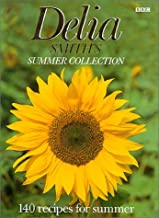 One person loves Delia Smith’s cookbooks from the early 2000s; this British author is well-known in the U.K. though none of us Yanks had heard of her. Her Piedmont roasted peppers are “spectacular!” It’s a simple, classic combo of peppers, tomatoes, basil, and anchovies roasted with olive oil and garlic; serve with crusty bread to mop up all the delicious juices. Fresh asparagus with foaming hollandaise is also a keeper with its “foolproof” hollandaise. Though Ms. Smith’s books aren’t widely available locally, her website has plenty of recipes for you to peruse. Staying with the Brits, Nigella Lawson provided a yummy red chilli jam recipe (” it’s a pretty color, too!”), and one for green sriracha as well (“It’s got a kick but it’s good!”). And, if you’re still drowning in tomatoes, try the tomato chutney recipe at the end of this post; it uses lots of green and/or red tomatoes, is “easy-peasy” and is excellent with cheese. This heirloom recipe is courtesy of our group member’s friend. Thank you, friend!
One person loves Delia Smith’s cookbooks from the early 2000s; this British author is well-known in the U.K. though none of us Yanks had heard of her. Her Piedmont roasted peppers are “spectacular!” It’s a simple, classic combo of peppers, tomatoes, basil, and anchovies roasted with olive oil and garlic; serve with crusty bread to mop up all the delicious juices. Fresh asparagus with foaming hollandaise is also a keeper with its “foolproof” hollandaise. Though Ms. Smith’s books aren’t widely available locally, her website has plenty of recipes for you to peruse. Staying with the Brits, Nigella Lawson provided a yummy red chilli jam recipe (” it’s a pretty color, too!”), and one for green sriracha as well (“It’s got a kick but it’s good!”). And, if you’re still drowning in tomatoes, try the tomato chutney recipe at the end of this post; it uses lots of green and/or red tomatoes, is “easy-peasy” and is excellent with cheese. This heirloom recipe is courtesy of our group member’s friend. Thank you, friend!
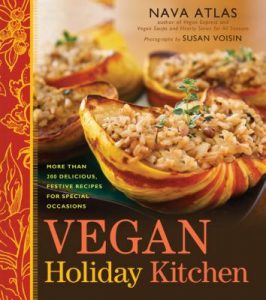 Vegan Holiday Kitchen by Nava Atlas is another older (2011) title that proved to be worth dusting off. Corn fritters with cilantro sauce were “fabulous” with their sweet and spicy tomatillo sauce. A keeper! Lemon, garlic, and rosemary potatoes were a good, classic combo, but they “needed more lemon.” Mixed greens with apples, beets and pistachios was another winner with its lemony dressing and tart cranberries accenting the main ingredients. One “klunker” was the red quinoa pilaf with kale and corn, which sounded good, but our cook didn’t care for the overall flavor profile.
Vegan Holiday Kitchen by Nava Atlas is another older (2011) title that proved to be worth dusting off. Corn fritters with cilantro sauce were “fabulous” with their sweet and spicy tomatillo sauce. A keeper! Lemon, garlic, and rosemary potatoes were a good, classic combo, but they “needed more lemon.” Mixed greens with apples, beets and pistachios was another winner with its lemony dressing and tart cranberries accenting the main ingredients. One “klunker” was the red quinoa pilaf with kale and corn, which sounded good, but our cook didn’t care for the overall flavor profile.
More older titles worth seeking out: Vegetables Everyday by Jack Bishop (“a classic!”); Cooking From the Farmers’ Market by Williams-Sonoma (“great photos, info on how to buy, how to work with”); Vegetable Love by Barbara Kafka (“encyclopedic– a Joy of Cooking for vegetables– but no pictures”); Too Many Tomatoes, Squash, Beans, and Other Good Things by Lois Landau (great title, but “no pictures!”).
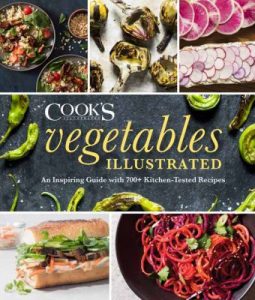 As for newer books, a few of us test-drove Vegetables Illustrated from America’s Test Kitchen. As is often the case with ATK titles, it’s an extensive and exhaustive treatment of its subject. This book is a heavy tome with plenty of enticing photos, and sometimes-lengthy headnotes, which some adore and others don’t! It’s organized by veggie name, which makes recipes easy to find when you’re faced with, say, that glut of zucchini. Speaking of which, the zucchini bread called for a full 1 1/2 pounds of shredded zuke! It was a light and tasty version of this ubiquitous quick bread. Another now-common recipe, avocado toast, was given star treatment with lemon zest and red pepper flakes. The recipe made us realize, again, how good something so simple can be when given a little care and attention. From the cabbage section, honey-mustard coleslaw was a hit. It had “a bit too much mustard” but was overall very good. There was also a helpful tip about wilting the cabbage with salt to cut down on excess moisture. Bulgur salad with carrots and almonds was a great option for a steamy day, since the only cooking bulgur needs is a soak at room temperature. This was a “refreshing” combination, with accents of mint and cilantro. Sweet potato, poblano, and black bean tacos were a flavorful vegetarian main dish; they featured a pickled onion garnish which was “so easy– so good!” There was general agreement that pickled onions are fabulous on just about everything!
As for newer books, a few of us test-drove Vegetables Illustrated from America’s Test Kitchen. As is often the case with ATK titles, it’s an extensive and exhaustive treatment of its subject. This book is a heavy tome with plenty of enticing photos, and sometimes-lengthy headnotes, which some adore and others don’t! It’s organized by veggie name, which makes recipes easy to find when you’re faced with, say, that glut of zucchini. Speaking of which, the zucchini bread called for a full 1 1/2 pounds of shredded zuke! It was a light and tasty version of this ubiquitous quick bread. Another now-common recipe, avocado toast, was given star treatment with lemon zest and red pepper flakes. The recipe made us realize, again, how good something so simple can be when given a little care and attention. From the cabbage section, honey-mustard coleslaw was a hit. It had “a bit too much mustard” but was overall very good. There was also a helpful tip about wilting the cabbage with salt to cut down on excess moisture. Bulgur salad with carrots and almonds was a great option for a steamy day, since the only cooking bulgur needs is a soak at room temperature. This was a “refreshing” combination, with accents of mint and cilantro. Sweet potato, poblano, and black bean tacos were a flavorful vegetarian main dish; they featured a pickled onion garnish which was “so easy– so good!” There was general agreement that pickled onions are fabulous on just about everything! 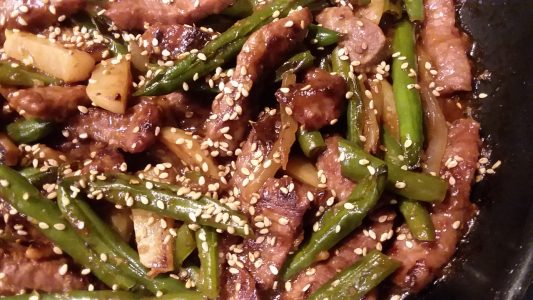 Beef and Chinese broccoli stir-fry was a quick and easy version of this classic dish; and while eggplant involtini was a bit involved, the results were worth the effort. It made nice leftovers, too.
Beef and Chinese broccoli stir-fry was a quick and easy version of this classic dish; and while eggplant involtini was a bit involved, the results were worth the effort. It made nice leftovers, too.
Other newer titles we checked out included Vegan for Everybody (also from the ATK lineup); The Berkshires Farm Table Cookbook by Elisa Bildner (the velvety zucchini soup was “lemony and delicious” and included arugula); Food, Health, and Happiness by Oprah Winfrey (with a dairy-free yet creamy summer corn chowder); and Vegetables Unleashed by Jose Andres. This title features “wonderful” pictures; author/chef/activist Andres (founder of World Central Kitchen) visits several farms and discusses farming practices. His Greek zucchini fritters were accented with a tasty yogurt-caper sauce. It’s worth noting that several people in the group had made zucchini fritters. It seems to be a popular, easy, and delicious way to get ahead of this prolific squash!
Though it wasn’t a month of revelations in the kitchen, we all thoroughly enjoyed the opportunity to get up close and personal with our veggies. Hopefully some (or all!) of the above titles will bring you some inspiration and “produce” some delicious dishes for you and yours. For September, we’ll once again be reading/cooking from the same title(s): three books by Christina Lane that are about small-batch cooking. All available at the main desk or via curbside pickup: Dinner Just For Two, Dessert Just For Two, and Comfort and Joy: Small-Batch Meals For Every Occasion. Our next meeting will be Friday, September 25 at 11 AM. We’ll chat via Zoom; if you’re not on our Bibliobites mailing list and would like to attend, please email group leader Andrea Grant. See you then!
Tomato Chutney
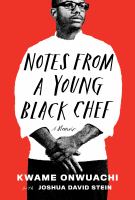
Bibliobites in July: The Soul of African-American and Southern Cuisine
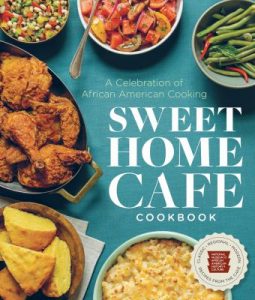 July 2020 will undoubtedly go down in the record books for its unending heat and humidity. It was so hot that the majority of our Bibliobites group admitted that it was just too hot to cook! But even if we couldn’t bear the idea of turning on the stove or standing in front of a hot grill, we could still escape into the world of food with books. This month we may not have done a lot of cooking, but there was an amazing amount of reading going on.
July 2020 will undoubtedly go down in the record books for its unending heat and humidity. It was so hot that the majority of our Bibliobites group admitted that it was just too hot to cook! But even if we couldn’t bear the idea of turning on the stove or standing in front of a hot grill, we could still escape into the world of food with books. This month we may not have done a lot of cooking, but there was an amazing amount of reading going on.
This month’s theme was African-American cuisine, which as it turns out is a broad topic, encompassing mostly Southern food in all its regional variations, which in turn has its roots in the Caribbean and West Africa. For our group of Northern cooks, many of the iconic dishes of the South are new-ish territory; so it was a big learning experience for all of us. Most of the books we explored also provided copious amounts of history, and though we may have known the basics, we all came away with a deeper understanding of African-American culture, as seen through the lens of food.
Two people perused Sweet Home Cafe by Albert Lukas and Jessica Harris. This book features recipes from the cafe at the National Museum of African-American History and Culture in Washington, DC. As one person commented, “It’s a history lesson with recipes.” There were some definite hits in this book: baby kale salad was “yummy” with its abundance of tomatoes, corn, scallions, and chives. The buttermilk dressing was a perfect topper. Jamaican jerk chicken was nicely spicy with hits of ginger and cinnamon, and sparkling watermelon and lemon verbena was a cooling, fruity drink, though a bit too sweet. However Frogmore stew, despite a stellar list of ingredients (sausage, shrimp, corn, potatoes) was disappointing– everything is boiled together with a lot of Old Bay seasoning, which our cook discovered she doesn’t like!
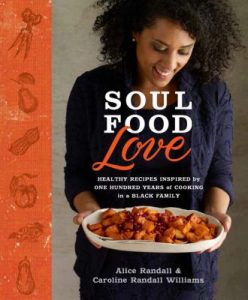 Soul Food Love by Alice Randall featured plenty of “typical” Southern ingredients, with a twist. Red beans and Creole rice salad was (thankfully) served cold, with a “nice dressing;” this salad was definitely hearty enough for a meal and would be good to take to a potluck. Fresh mint cucumber lime water was “basic but refreshing” and could also be made with sparkling water if you enjoy the bubbles. And black-eyed pea hummus was “very creamy– the texture was like pate!”
Soul Food Love by Alice Randall featured plenty of “typical” Southern ingredients, with a twist. Red beans and Creole rice salad was (thankfully) served cold, with a “nice dressing;” this salad was definitely hearty enough for a meal and would be good to take to a potluck. Fresh mint cucumber lime water was “basic but refreshing” and could also be made with sparkling water if you enjoy the bubbles. And black-eyed pea hummus was “very creamy– the texture was like pate!”
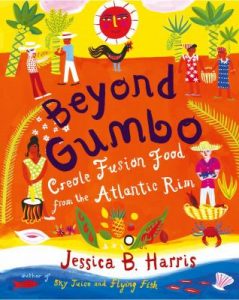 The prolific Jessica Harris brought us Beyond Gumbo: Creole Fusion Food From the Atlantic Rim. Though we associate Creole cooking with New Orleans, it’s been influenced by African and Caribbean flavors, and features many ingredients that appear in almost all Southern cookbooks. For instance, seafood gumbo had lots of celery, onion, and garlic; but despite this common and tasty trio, the dish somehow “didn’t come together.” Cuban black beans were flavored with bay leaf, peppers, and onions; this was a solid combination but not outstanding. Chicken and andouille etouffee lost some points for requiring one cup of oil for the roux, which seemed excessive (even if it is traditional). Overall it was a disappointing title, and to make matters a bit worse, the only illustrations were antique postcards– there were no pictures of the food.
The prolific Jessica Harris brought us Beyond Gumbo: Creole Fusion Food From the Atlantic Rim. Though we associate Creole cooking with New Orleans, it’s been influenced by African and Caribbean flavors, and features many ingredients that appear in almost all Southern cookbooks. For instance, seafood gumbo had lots of celery, onion, and garlic; but despite this common and tasty trio, the dish somehow “didn’t come together.” Cuban black beans were flavored with bay leaf, peppers, and onions; this was a solid combination but not outstanding. Chicken and andouille etouffee lost some points for requiring one cup of oil for the roux, which seemed excessive (even if it is traditional). Overall it was a disappointing title, and to make matters a bit worse, the only illustrations were antique postcards– there were no pictures of the food.
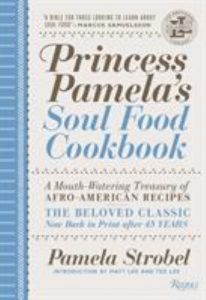 Princess Pamela’s Soul Food Cookbook by Pamela Strobel is a 45-year old classic that is now back in print. This title features classic African-American recipes like mixed greens (“I used kale and pancetta”) and hot Southern cabbage with a vinegar and sugar dressing. Carla Hall, “Top Chef” alumnus, has a new one out called Soul Food: Everyday and Celebration.
Princess Pamela’s Soul Food Cookbook by Pamela Strobel is a 45-year old classic that is now back in print. This title features classic African-American recipes like mixed greens (“I used kale and pancetta”) and hot Southern cabbage with a vinegar and sugar dressing. Carla Hall, “Top Chef” alumnus, has a new one out called Soul Food: Everyday and Celebration. 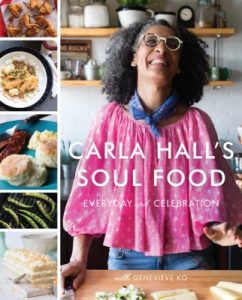 As was true of many books we test-drove this month, it includes backstories for the recipes along with family history. One person tried the seared summer squash with sage; the squash is cooked long and slow until super-tender. This was “OK…I don’t think I cooked the squash long enough.” Interestingly there’s an audio version of this title, read by the author. We were curious as to how that would work out for cooking purposes!
As was true of many books we test-drove this month, it includes backstories for the recipes along with family history. One person tried the seared summer squash with sage; the squash is cooked long and slow until super-tender. This was “OK…I don’t think I cooked the squash long enough.” Interestingly there’s an audio version of this title, read by the author. We were curious as to how that would work out for cooking purposes!
That was about the extent of our cooking adventures, but reading– wow! There are so many great titles to tell you about, and when the weather cools off somewhat we’ll be able to try out many of the recipes we discovered. Here’s a sampling: 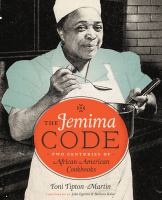 The Jemima Code by Toni Tipton-Martin traces the history of African-American cooking through a century’s worth of cookbooks written by women; Thirty Years at the Mansion: Recipes and Recollections by Liza Ashley details the author’s experiences as cook in the Arkansas governor’s mansion. The author provides favorite recipes of each governor, in addition to (politely)dishing the dirt on her employers, including Bill Clinton. Unfortunately no MVLC library owns this title. A Real Southern Cook
The Jemima Code by Toni Tipton-Martin traces the history of African-American cooking through a century’s worth of cookbooks written by women; Thirty Years at the Mansion: Recipes and Recollections by Liza Ashley details the author’s experiences as cook in the Arkansas governor’s mansion. The author provides favorite recipes of each governor, in addition to (politely)dishing the dirt on her employers, including Bill Clinton. Unfortunately no MVLC library owns this title. A Real Southern Cook 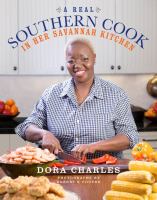 by Dora Charles showcases recipes from the Savannah area; Ms. Charles cooked at Paula Deen’s restaurant and they had a long and “complicated” working relationship. She left Deen’s employ amid allegations of racism and has since worked to create her own legacy. The New Lowcountry Cookbook by Marvin Woods (an older title no longer available through MVLC) features new takes on traditional foods of that area; and Southern Girl Meets Vegetarian Boy by Damaris Phillips uses classic Southern “core recipes,” and then modifies them for both vegetarians and vegans.
by Dora Charles showcases recipes from the Savannah area; Ms. Charles cooked at Paula Deen’s restaurant and they had a long and “complicated” working relationship. She left Deen’s employ amid allegations of racism and has since worked to create her own legacy. The New Lowcountry Cookbook by Marvin Woods (an older title no longer available through MVLC) features new takes on traditional foods of that area; and Southern Girl Meets Vegetarian Boy by Damaris Phillips uses classic Southern “core recipes,” and then modifies them for both vegetarians and vegans.
Many of the titles we read were either memoirs or a memoir/cookbook combination. These were uniformly wonderfully written, heartfelt, and inspiring. Check out:  Notes From a Young Black Chef by Kwame Onwuachi; The Cooking Gene
Notes From a Young Black Chef by Kwame Onwuachi; The Cooking Gene  by Michael Twitty; and Yes Chef by Marcus Samuelsson. Samuelsson also has a cookbook, The Red Rooster Cookbook, about his restaurant in Harlem; in addition to recipes, it’s a quasi-memoir about his journey to find a place to call home after decades of cooking all over the world. All these memoirs have in common an immensely strong protagonist who never gave up on himself or his goals despite overt and abundant racism. These chefs are possessed of an incredible work ethic and an enduring desire to bring what they know and love to the world. We’re in awe of their persistence and energy.
by Michael Twitty; and Yes Chef by Marcus Samuelsson. Samuelsson also has a cookbook, The Red Rooster Cookbook, about his restaurant in Harlem; in addition to recipes, it’s a quasi-memoir about his journey to find a place to call home after decades of cooking all over the world. All these memoirs have in common an immensely strong protagonist who never gave up on himself or his goals despite overt and abundant racism. These chefs are possessed of an incredible work ethic and an enduring desire to bring what they know and love to the world. We’re in awe of their persistence and energy.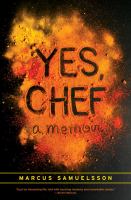
August is the month of corn and tomatoes, so for our next meeting we have been perusing titles that feature vegetables in all their seasonal glory. Choose a book from a selection at the main desk, or use a book you have at home. We’ll meet via Zoom on Friday, August 28 at 11 AM. If you would like to join us and aren’t already on our mailing list, please email program leader Andrea Grant at agrant@chelmsfordlibrary.org. Hope to see you then!

Bibliobites in April: D is for Downloadable
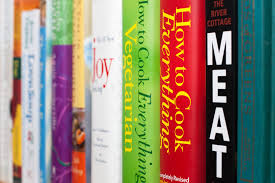 Cookbooks… if you like to play in the kitchen, you can never have enough of them. At home you may have several shelves full of well-thumbed favorites, but it’s equally intriguing (and educational!) to peruse the latest titles, explore emerging trends, learn new techniques, and discover a new-to-you cuisine. With the library’s building closed for now, we can’t hang out in the 641s, browsing through books on the shelf until we find the one that speaks to us. But, luckily for us, the Chelmsford Library offers plenty of virtual alternatives, which our group tackled this month with great energy and enthusiasm!
Cookbooks… if you like to play in the kitchen, you can never have enough of them. At home you may have several shelves full of well-thumbed favorites, but it’s equally intriguing (and educational!) to peruse the latest titles, explore emerging trends, learn new techniques, and discover a new-to-you cuisine. With the library’s building closed for now, we can’t hang out in the 641s, browsing through books on the shelf until we find the one that speaks to us. But, luckily for us, the Chelmsford Library offers plenty of virtual alternatives, which our group tackled this month with great energy and enthusiasm!
 Starting with the basics, most of us downloaded titles from Overdrive or Hoopla. While Overdrive is accessible to anyone who has any Merrimack Valley Consortium library card, in order to use our Hoopla service you do need to be a Chelmsford resident.
Starting with the basics, most of us downloaded titles from Overdrive or Hoopla. While Overdrive is accessible to anyone who has any Merrimack Valley Consortium library card, in order to use our Hoopla service you do need to be a Chelmsford resident. However, nearby Westford and Carlisle also offer Hoopla to their cardholders, while Billerica and Lowell direct you to information about the Boston Public Library’s ecard. This card is available online to any Massachusetts resident, and provides access to a wide range of e-resources, including Hoopla, Overdrive, and much more.
However, nearby Westford and Carlisle also offer Hoopla to their cardholders, while Billerica and Lowell direct you to information about the Boston Public Library’s ecard. This card is available online to any Massachusetts resident, and provides access to a wide range of e-resources, including Hoopla, Overdrive, and much more.
Everyone found both Overdrive and Hoopla simple to navigate, even if they’d never used them before. And we quickly discovered one of the virtues of virtual books– it was amazingly easy to quickly flip through titles and decide if we wanted to spend more time on a particular book, or maybe buy it later. And of course, the key attribute is that ebooks are accessible anytime, anywhere. But….there were some downsides. Recipes tended to take up more pages than print versions, which led to a lot of flipping back and forth while trying to cook. Those who tried to print recipes were frustrated that they couldn’t efficiently print the whole thing on one page; it printed with the same number of pages as the recipe took up in the ebook, which led to a lot of wasted paper. And of course we all missed having a physical book in our hands; an ebook “doesn’t draw you in….it’s a more remote (!) experience.”
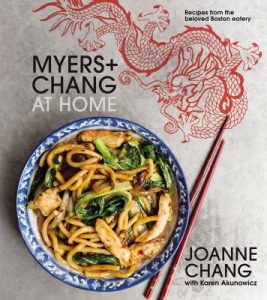 Also, the selection of titles available in e-version is much smaller, so if you wanted a particular author or title, sometimes you were out of luck. Some that we looked at and enjoyed were: Myers and Chang at Home by local favorite Joanne Chang; Magnolia Table by serial entrepreneur Joanna Gaines; 5 in 5 by restaurateur Michael Symon; anything by Jacques Pepin (“there were lots of his books on Hoopla”); and The Farmer’s Wife Cookbook by Joanna Engstrom, a 1930s title that was fun to browse. It even included advice on how to buy that newfangled appliance, the refrigerator!
Also, the selection of titles available in e-version is much smaller, so if you wanted a particular author or title, sometimes you were out of luck. Some that we looked at and enjoyed were: Myers and Chang at Home by local favorite Joanne Chang; Magnolia Table by serial entrepreneur Joanna Gaines; 5 in 5 by restaurateur Michael Symon; anything by Jacques Pepin (“there were lots of his books on Hoopla”); and The Farmer’s Wife Cookbook by Joanna Engstrom, a 1930s title that was fun to browse. It even included advice on how to buy that newfangled appliance, the refrigerator!
Some of us had a stash of cookbooks at home that we’d picked up before the library closed, or that we ordered online. We enjoyed two titles from prolific America’s Test Kitchen: Sous Vide For Everybody, and Twentieth Anniversary TV Show Cookbook (“it’s a big book!”). One person perused Melissa Clark’s newest, Dinner in French. Many recipes looked enticing, although “she uses lots of spices that aren’t so easy to find.” 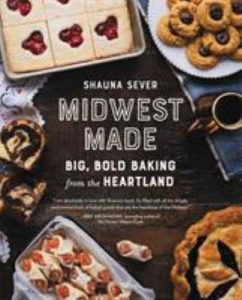 Midwest Made by Shauna Sever proved to be a volume of yummy, no-fuss baked goods, and Eat Your Vegetables by Joe Yonan was a unique collection of cooking-for-one vegetarian recipes. And we all encountered one problem, regardless of book type: inevitably, after choosing a recipe we found we were lacking one or two critical ingredients– and all of us are shopping less and much more cautiously. No more running to the supermarket at the last minute, or for just a few items!
Midwest Made by Shauna Sever proved to be a volume of yummy, no-fuss baked goods, and Eat Your Vegetables by Joe Yonan was a unique collection of cooking-for-one vegetarian recipes. And we all encountered one problem, regardless of book type: inevitably, after choosing a recipe we found we were lacking one or two critical ingredients– and all of us are shopping less and much more cautiously. No more running to the supermarket at the last minute, or for just a few items!
Besides books, we visited plenty of websites, and these overall were preferred to ebooks. Many in the group already have “go-to” sites or blogs, whether created by author, magazine, or TV show. The resources really are almost unlimited. And, with various meetings and activities cancelled (and a much shorter commute, if you can work from home), we now have more time to delve into various cooking projects– carefully planned ahead, of course, due to the aforementioned need to shop less, as well as the well-documented shortage of some ingredients, like flour or yeast (and heaven forbid you want brownie mix!). The Epicurious site, and others, now has a feature on its website, a “cook with what you’ve got recipe finder,” a notion that many are perforce embracing. One person mentioned that her adult children text her a photo of what’s in their fridge, and then challenge her to create a meal out of what’s there. Hopefully they take turns as to who has to come up with a dinner idea! This concept also applies to equipment problems, as one person’s oven is broken, and parts have been slow to arrive. So, lots of slow cooker stews, stovetop sautes, and baking in a tiny toaster oven. The shortage of flour and yeast has also spurred creativity; non-wheat flours have come into play, as well as breads that don’t rely on yeast, like soda bread, beer bread or cornbread.
As much as we have a newfound appreciation for our downloadable resources, most of us would still far prefer to have a “real” book in our hands. A big part of this is familiarity; perhaps after using e-books for a while we’ll enjoy their unique attributes more, and come to rely on them.  It makes me think of the shift from typewriters to word processing, which we all hated at first because it seemed so cumbersome, and was such a different way of doing things; the advantages weren’t (for some reason) readily apparent. But, would any of us really want to return to using a typewriter today? We’ve all become accustomed to, and appreciate the ease of, composing on a screen, despite software quirks. Of course, the big missing piece with an e-book is the tactile experience, and for people who love to snuggle up with a good book (cookbook or otherwise), hunkering down with your phone or tablet just isn’t the same. I’m sure there’s a neurological reason for this preference; maybe our human need for connection– and touch– extends even to certain inanimate objects? Our excursion into the virtual may have been delightful and delicious, but it’s doubtful that, right now, most of us would desire to do our reading, or cooking that way. This month I asked everyone for a vote on the overall experience with e-books, and while we definitely appreciate having this resource available, no one was ready to fully embrace it– yet! So, most of the voting was in the 1-2 range (out of a possible 5). I think that works out to a grade of D!
It makes me think of the shift from typewriters to word processing, which we all hated at first because it seemed so cumbersome, and was such a different way of doing things; the advantages weren’t (for some reason) readily apparent. But, would any of us really want to return to using a typewriter today? We’ve all become accustomed to, and appreciate the ease of, composing on a screen, despite software quirks. Of course, the big missing piece with an e-book is the tactile experience, and for people who love to snuggle up with a good book (cookbook or otherwise), hunkering down with your phone or tablet just isn’t the same. I’m sure there’s a neurological reason for this preference; maybe our human need for connection– and touch– extends even to certain inanimate objects? Our excursion into the virtual may have been delightful and delicious, but it’s doubtful that, right now, most of us would desire to do our reading, or cooking that way. This month I asked everyone for a vote on the overall experience with e-books, and while we definitely appreciate having this resource available, no one was ready to fully embrace it– yet! So, most of the voting was in the 1-2 range (out of a possible 5). I think that works out to a grade of D!
 Our next meeting will be via Zoom on Friday, May 29 at 11 AM. We would love to see some new faces next month – please let us know if you interested in joining us by emailing program leader Andrea Grant at agrant@chelmsfordlibrary.org — We’ll be discussing Jamie Oliver’s 5 Ingredients: Quick & Easy Food. While we can’t provide the physical book, most of the recipes from this title are available on his website, jamieoliver.com. He also cooks from this book on CreateTV; check local listings for channel and time. Stay safe, stay well, and see you then!
Our next meeting will be via Zoom on Friday, May 29 at 11 AM. We would love to see some new faces next month – please let us know if you interested in joining us by emailing program leader Andrea Grant at agrant@chelmsfordlibrary.org — We’ll be discussing Jamie Oliver’s 5 Ingredients: Quick & Easy Food. While we can’t provide the physical book, most of the recipes from this title are available on his website, jamieoliver.com. He also cooks from this book on CreateTV; check local listings for channel and time. Stay safe, stay well, and see you then!





